August 31 - September 6, 2014: Issue 178
John Collins
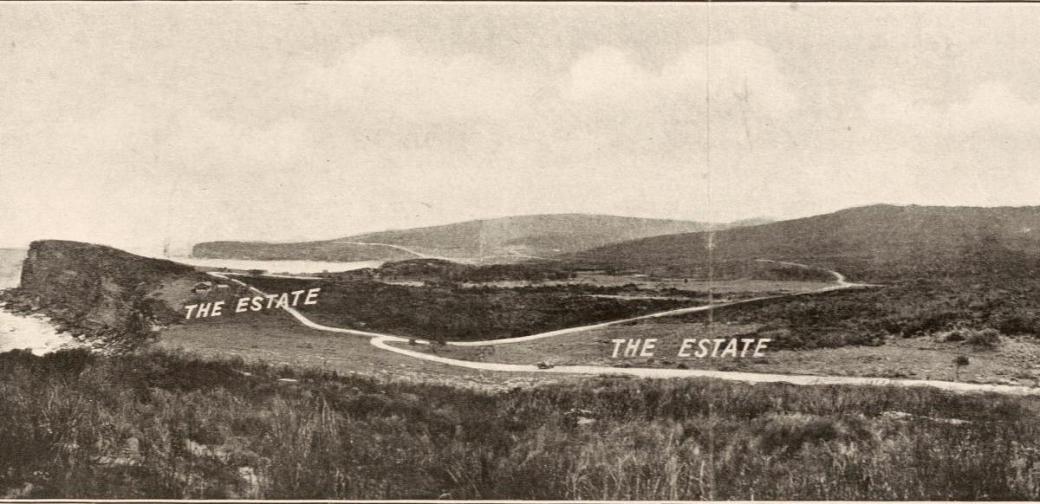
Section showing John Collins Dairy Fields - from Stanton & Son. Careel Ocean Beach estate [cartographic material] : "The hole in the wall", 2nd subdivision, 1922. MAP Folder 37, LFSP 499. Part 1. and Stanton & Son. Careel Ocean Beach estate [cartographic material] : "The hole in the wall", 2nd subdivision 1922. MAP Folder 37, LFSP 499. Part 2., courtesy National Library of Australia.
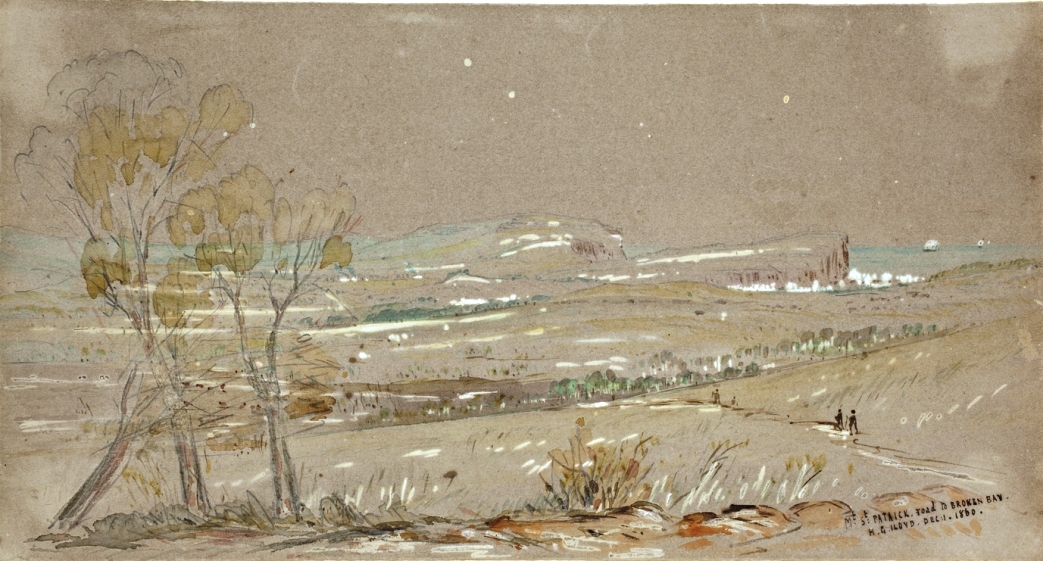
John Collins
16th of May 1815 – 21st of May 1881
Called by many in the early rural district of Pitt Water the 'Patriarch of Pittwater', John Collins was the eldest son born to Jeremiah and Catherine Collins (Nee Roche) at Annakissy, Killavullen Parish, Ireland. Shelagh Champion OAM and George Champion OAM, in theirProfiles of the Pioneers (2013 - Warringah Shire Library) state Jeremiah and Catherine had four known sons, John, Francis (Frank), William and Æneas and two daughters, Mary and Catherine. A US relative who has been researching this branch of his family also lists two of the Collins sisters, Margaret, who married Jeremiah Hartnett (also from Cork) in Sydney in 1846, and Ellen immigrating to San Francisco at the height of the California Gold Rush in 1849. There are four other daughters listed in Church records, Bridget and Hanora, and two Mary's (one born in 1811 and the other in 1828). Of the 17 children the couple had baptised, only 12 were known to still be living when they embarked for New South Wales.
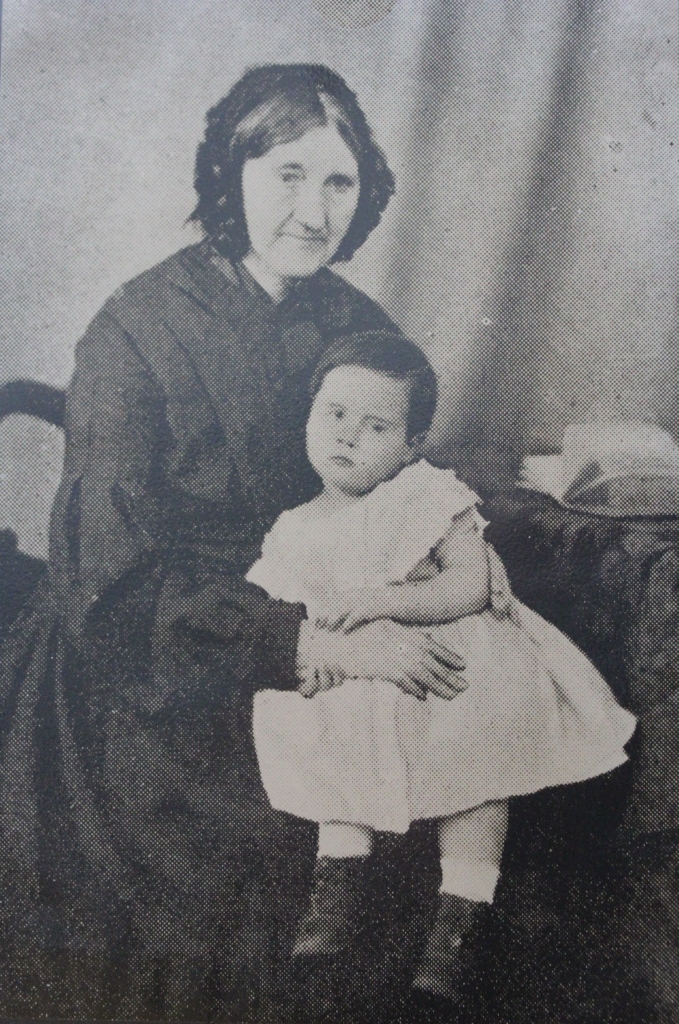
Catherine Collins - photo courtesy Avalon Beach Historical Society
Phil Michelson of California on Jeremiah and Catherine: Jeremiah immigrated to Sydney, NSW with 12 of his children aboard the Elphinstone in 1840. He had been evicted from the Pierce Nagle Estate at Clenor even though he had paid his rent on time.
Many other tenants were evicted from the same estate during these years. The Elphinstone sailed into Sydney in October of 1840 - a check of the ships records shows only three of the sons aboard - John, Aenas and William. The Champion's research points to Jeremiah and Catherine arriving later:
Shipping Intelligence. ARRIVALS-YESTERDAY. ELPHINSTONE, barque, Friendlen, master, from London and Plymouth the 3rd of June, Gore and Co., Agents. Cargo-Merchandise. Passengers - Cabin - Mr. Capper, Captain Edinborough and Lady. Mr. Arthur Edinborough. Mr. Thomas Boyed. Intermediate - Mr. and Mrs. Levy,Mr. Forsyth, Mr. Hynd, Mr. Cullender, Mr. Gibbes, Miss Roach, and two hundred and forty-eight Emigrants, under the command of D.M. Salter, Esq., Surgeon. Shipping Intelligence. (1840, October 9). The Sydney Monitor and Commercial Advertiser (NSW : 1838 - 1841), p. 3 Edition: MORNING. Retrieved fromhttp://nla.gov.au/nla.news-article32185727
Ship News. By the Elphinstone from London, we have received 248 emigrants, who appear to be a most respectable set of people, and principally agriculturists. They have arrived in a healthy condition, notwithstanding that during the passage out, a slight case of fever was witnessed, which occasioned the death of four adults and six infants. This is the second vessel arrived from the firm of Carter and Bonus, and are sent out in addition to Marshall's emigrants. They consist of 158 adults, 28 children, between the age of seven and fourteen years, and fifty-five infants. The Himalaya, from London, bound to Port Phillip, with emigrants, was spoken by the Elphinstone, on the 11th September in lat. 38 ° 40' S , long. 90 ° 30' E., out 80 days, all well. The Mary Dugdale from Liverpool, bound to Adelaide with emigrants, and out 19 days, was spoken by the Elphinstone on the 29th of June, in lat. 8 ° N. Ship News. (1840, October 10). The Sydney Gazette and New South Wales Advertiser (NSW : 1803 - 1842), p. 2. Retrieved, from http://nla.gov.au/nla.news-article2539219
John Doyle, a relative of the Collin's had been transported for insurrection in 1823 according to family letters held by Mr. Michelson. The Irish Insurrection Act (1822) saw around 30,000 men and 9,000 women transported directly from Ireland. Apart from those from the cities of Dublin and Cork, the majority were from rural areas and were first offenders. Many were nationalists fighting British domination, or social rebels protesting against a harsh and unjust law which condemned them to poverty and starvation. [A G L Shaw]
Mr. Doyle, once he gained his Ticket of Leave here, became a Pitt Water tenant of Rev. J J Therry, who also hailed from Cork and was very keen to help those he saw as being harshly treated at home and just as harshly targeted here.
From the Champion's Profiles of the Pioneers:
John Doyle, whose native place was County Cork, had been sentenced to seven years transportation on 14 September 1822, arriving in New South Wales by the Earl St. Vincent in 1823. His year of birth was 1798. He was 5 feet 7 inches tall, with a ruddy complexion, brown curly hair and chestnut eyes. John Doyle of Pittwater was granted his Ticket of Leave on 29 December 1827. [AO TL 27/938] He was employed as David Foley’s ploughman in 1828.
On 22 December 1837 David Foley wrote to Father Therry: “Revd. Sir, I have to inform you that I have seen Doyle and Culhane as you requested, they told me they intend to remain another year and that they will pay their rent as soon as they can get their Produce to Sydney.” Again, on 14 February 1839 Foley wrote Father Therry’s agent, John O’Sullivan, “J. Doyle I saw several times, respecting his rent, he promised to pay but as yet has neglected to do so. He is in partnership with another Man on the Farm.” As they treated Foley and his authority as “useless”, he suggested the execution of a distress warrant against them to obtain the rent. [ML MSS 1810/18 p.199; 1810/55 p.137a-b]
John Doyle and Thomas Culhane wrote to John O’Sullivan from Pittwater on 12 August 1839:
“Sir, Having seen the Revd. J.J. Therry’s overseer some few days since and being informed that he was empowered to rent the farm which I now occupy, my lease being out, I beg leave to state to you that I should be willing to hold possession of the farm as usual at a fair rent (namely) 30£ per annum which is as much as it ever realised - you being aware that none of the Revd. Mr Therry’s tenants ever paid him any rent at least but a small trifle - and me being a tenant under the above Gentleman so long, I consider I should have the first preference. I am willing to find security for the rent if required. I am a very old resident in that District and my Cattle being Bred here it will put me to an ill convenience which I flatter myself you will take into consideration.
...I am rather surprised to find that Mr Foley should be appointed to fix a rent on the farm after all the improvements I have made on it.” The rent was £16 per annum. “...There is one year’s Rent due but I beg leave to state that there is some accounts between me and Mr Therry which was to be allowed me for some improvements made on the Farm, (namely) Ploughing the Ground in the first instance together with fencing some of the said Ground, Doors for the House, and some Wheat & Maize that was given to some of the Men by Mr Therry’s orders, the whole amounting to about 9£ which still leaves the balance of about 7£ which I will settle when I receive your answer.” A note at the top of the letter states: “He took a new piece of ground & fenced for his own use & advantage.” Another note at the end of the letter states, “Rent £45 from 1 Septr. Mr Hurly Security.” [ML MSS 1810/55, p.193-5]
On 29 February 1840 Doyle and Culhane wrote again, to know whether they should pay the rent to Mr Hurley or into the bank, “if it is in the Bank mention to us the name of the Bank it is to be paid in two as it will be Due next month.” A reply to their letter was to be sent to David Jordan at the Bird in Hand, Gloucester Street, Sydney, to be forwarded to Thomas Culhane. [ML MSS 1810/55, p.325-8]
John Doyle drowned in Pittwater on January 20th, 1841:
INQUEST.-An inquest was held on Tuesday morning at the house of Mr. Murphy, the Sign of the Bard's Legacy, Queen's Wharf on the body of John Doyle, who was accidentally drowned by the upsetting of a boat at Pitt Water, on Wednesday, the 20th instant. The body was found at Broken Bay on Monday last by some fishermen,who brought it to Sydney. It appeared from the evidence that the persons who were in the boat along with deceased at the time the accident occurred, as well as deceased himself, were perfectly sober, and the jury returned a verdict of accidental death. THE REGATTA. (1841, January 28). Australasian Chronicle(Sydney, NSW : 1839 - 1843), p. 3. Retrieved from http://nla.gov.au/nla.news-article31730651
Records indicate that Mr. Doyle was not the only man to lose his life in small boats on Broken Bay that year:
James M'Quillan. Pilot, Brisbane Water, was unfortunately drowned while crossing from Pitt Water to Brisbane Town, by his boat being caught in a squall and capsizing. Mr. M'Quillan is much regretted Summary of Public Intelligence. (1841, July 31). The Sydney Gazette and New South Wales Advertiser (NSW : 1803 - 1842), p. 2. Retrieved from http://nla.gov.au/nla.news-article2554037
A few days ago, as Mr. James M'Quillen, the pilot at Brisbane Water, was crossing in his own boat from Pitt Water to Brisbane a squall upset the boat, and Mr. M’Quillen and a man named George Ford, who was with him at the time, were both unfortunately drowned. The body of Mr. M’Quillen was found lying upon the beach, but the body of Ford has not since been heard of. Insolvent Debtors' Court. (1841, July 31). Australasian Chronicle (Sydney, NSW : 1839 - 1843), p. 2. Retrieved from http://nla.gov.au/nla.news-article31732459
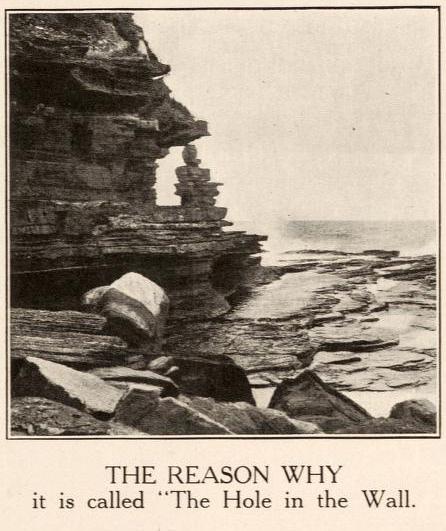 COLLINS, Jeremiah: Hole in the Wall, Parish Broken Bay, County Cumberland, District Sydney.
COLLINS, Jeremiah: Hole in the Wall, Parish Broken Bay, County Cumberland, District Sydney.
The Collins family engaged in farming, with John Collins running the farm when his father Jeremiah passed away soon after the son named for him did:
FUNERAL. — The friends of Mr. Jeremiah Collins, Pitt Water, are requested to attend the funeral of his deceased son, Jeremiah, to move from the Ferry Wharf, Windmill - street, Tomorrow, Wednesday afternoon, at half-past three o'clock. JAMES CURTIS, Undertaker. Hunter-street, October 5. Family Notices. (1852, October 5). The Sydney Morning Herald(NSW : 1842 - 1954), p. 3. Retrieved from http://nla.gov.au/nla.news-article12940492
FUNERAL.—The friends of the late Mr. JEREMIAH COLLINS, Pitt Water, are requested to attend his Funeral, to move from the Ferry Wharf, Windmill-street, this (Wednesday) afternoon, at five o'clock. JAMES CURTIS, Undertaker. Hunter-street, November 10. Family Notices. (1852, November 10). The Sydney Morning Herald (NSW : 1842 - 1954), p. 3. Retrieved from http://nla.gov.au/nla.news-article12941451
Jeremiah's wife Catherine went to live with her daughter Catherine, now wife of Bernard Daly. She passed away in 1872. Bernard Daly, prior to his passing, transferred the licence of the Union Inn to his brother in law, John Connolly, also of Cork, and his sister-in-law, Mary (nee Collins), who some may recall from our history page on the Broken Bay Customs Station under the tenure of Albert Thomas Black:
By special license, on the 17th April, at the Roman Catholic Chapel, North Shore, by the Rev. Peter Powell, Mr. Bernard Daly, Union Inn, North Shore, to Miss Catherine Collins, daughter of the late Jeremiah Collins, Pitt Water. Family Notices. (1856, April 18). The Sydney Morning Herald(NSW : 1842 - 1954), p. 1. Retrieved fromhttp://nla.gov.au/nla.news-article12981900
Albert Thomas Black, Collector of Customs at Barranjuie, deposed to starting with his crew to the rescue of some men in a boat which he heard had upset; he rescued George Williams, John Walker, and deceased (whom he believed to be dead),and seeing that a boat was making for Francis Smith, and considering him safe to be picked up, he made for home; he tried for a couple of hours to restore life in Tucker, but failed; he desired to mention the heroic conduct of a lad named Jeremiah Connolly, who, of his own accord, put off in a small boat to save these drowning men. John Connolly, one of Mr. Black's crew, gave evidence as to the up-setting of the boat, which he witnessed from the shore. From the evidence adduced, Mr, Smith, gave it as his opinion that death had resulted from drowning. FATAL OCCURRENCE AT BARRANJUIE, BROKEN BAY. (1871, December 29). The Sydney Morning Herald (NSW : 1842 - 1954), p. 9. Retrieved from http://nla.gov.au/nla.news-article13250096
COLLINS—April 13, at the residence of her son-in-law, Mr. Bernard Daly, Union Inn, North Shore, Mrs. Catherine Collins, relict of the late Jeremiah Collins, of Pitt Water, aged 81 years. Family Notices. (1872, April 20). The Sydney Morning Herald(NSW : 1842 - 1954), p. 7. Retrieved from http://nla.gov.au/nla.news-article13256066
The license of the Union Inn, St. Leonards, from Bernard Daly to John Connolly. WATER POLICE COURT. (1877, March 28). The Sydney Morning Herald (NSW : 1842 - 1954), p. 7. Retrieved from http://nla.gov.au/nla.news-article13387885
A very old resident of the Shore, Mr. Bernard Daly, late of the Union Inn, was buried last week. He was a civil, obliging, honest man, whose house was always open to weary travelers, some of whom would remain days without paying him a penny. He and his late wife were those ideal innkeepers so highly spoken of by that great saint Francis De Sales, who said 'that he saw no condition in life which furnished greater means of serving God in our neighbour, and advancing heavenward, because it keeps a man continually engaged in works of mercy, although like the physician he receives his salary.' Mr. Daly was instrumental in procuring from the Government the unrivalled site upon which the Catholic Church stands. In his last days his spiritual wants were constantly attended to by Dean Kenny; and Mrs. Connolly, his sister-in-law, Mrs. Boyd, and Mr. John Collins of Pittwater, his brother-in-law, left nothing undone that would conduce to his comfort. He has left four grown-up children, who are well provided for. ST. LEONARDS. (1877, October 13).Freeman's Journal(Sydney, NSW : 1850 - 1932), p. 10. Retrieved from http://nla.gov.au/nla.news-article115375940
John married Honorah (nee Stanton) in 1847. Their children were Ellen (b.1848), Patrick John, Margaret (b.1850), Jeremiah Joseph (b.1851), Katherine Mary (b.1853), Francis Edmund (b.1855) and twins John and Matthew Æneas (b.1859).
In the Life and Letters of Rev JJ Therry, reference is made to a Dr. Bergin being in charge of the Pittwater properties given in Land Grants to the Arch-priest - John O'Sullivan, who had earlier worked with the J J Therry on behalf of newly landed Catholics, and still looked after his interests even after he had died, had become a Manager of the Commercial Bank at Goulburn, where he would remain for 31 years until retirement in 1867. This may be Dr. Bergin's 'strayed' equine:
A REWARD.-Stolen or Strayed, from Mr. John Collins paddock, Pittwater, one HORSE COLT, two years old, brownish colour, small white star in forehead, branded on near shoulder B. Any person bringing me information to his recovery two pounds reward, if stolen, ten pounds reward, on conviction of the thief. Advertising. (1857, October 21). The Sydney Morning Herald(NSW : 1842 - 1954), p. 1. Retrieved fromhttp://nla.gov.au/nla.news-article13001858
This would not be the only time someone was reaching into the pocket of John Collins:
Christopher Coyle was brought, before the Court by police-sergeant Smith, charged with stealing a silver watch, value £4. John Collins, farmer, of Pitt Water, stated that he was in Sydney on Friday, the 29th ultimo, and had the watch in his trousers' pocket. He did not know how he lost it, but he missed it about 8 o'clock. He did not recollect having seen prisoner before. Sergeant Smith happened to call at Sly's pawn office, just us the prisoner was offering the watch in pledge. Committed for trial at next Quarter Sessions.WATER POLICE COURT. (1866, July 5). The Sydney Morning Herald (NSW : 1842 - 1954), p. 5. Retrieved fromh ttp://nla.gov.au/nla.news-article28612209
John and his brother Frank ran the farm, essentially a dairy. It is a description by Charles De Boos in his 1861 My Holiday series of Articles, that allows us to see what or how John or his brother may have spoken and what the farm looked like:
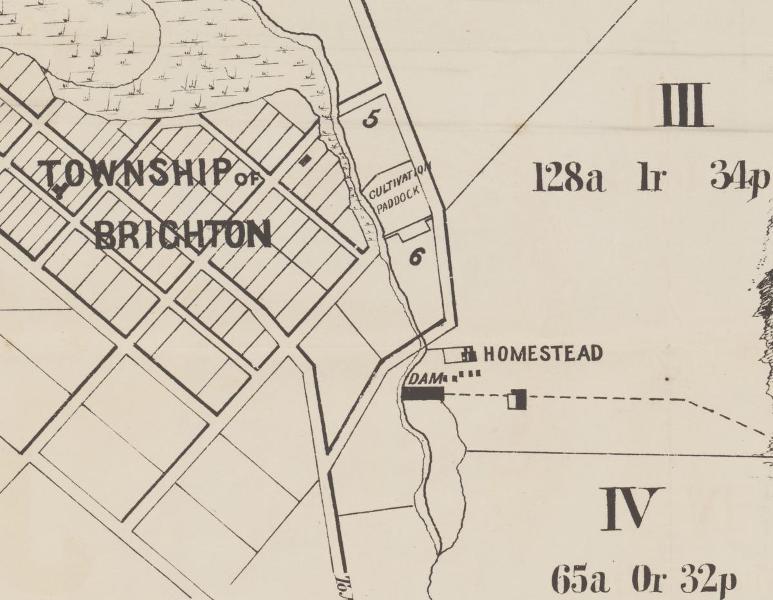
Section from: Careel Bay Pittwater [cartographic material] : township of Brighton, 8 blocks of land with ocean frontage - 1882. MAP Folder 135, LFSP 2160. Courtesy National Library of Australia.
After crossing the creek, we came in sight of a homestead, small but neat, having evidently been only recently whitewashed. The paddock was now clear of all undergrowth, and, as a goodly cluster of large trees, the remnants of the former occupants of the soil, had been left standing round the house, it had an exceedingly pretty and picturesque appearance, its white sides gleaming out markedly from amongst the bright green of the shrubs around it, and the dark and sombre verdure of the forest monarchs that overshadowed it.
"This," said Tom, "is Tom Collins, and he's the man that will show us the cave."
“The cave ?" asked I. "What cave ?".....
A tap at the door brought out the mistress of the house, accompanied by her brood of little ones, all fat, chubby, and rosy faced, bearing on their countenances the imprimatur of good health. Having mentioned our errand, we were invited to enter, and we found the interior of the domicile even more neat, and white, and bright, than the exterior, for it was the very beau ideal of cleanliness, and care. The tin-ware which hung from the shelves was polished till it shone like silver, whilst the shelves themselves being of deal, were scoured almost to whiteness. The floor, though an earthern one, was swept so clean that it more resembled a single large slab of stone than what it really was; and the fire in the huge bush fireplace was nicely kept in the centre, each side being swept as carefully as the floor itself had been. The hut had been recently whitewashed throughout, and the whole had such a light and cleanly air as strongly to remind me of some of the farmhouses it has been my lot to visit in the mother country, where, perchance, some notable housewife would take such a pride in polishing that even to the iron hoops of the churn, the piggins or the milk coolers would be burnished up till they resembled steel.
Unfortunately our man, Tom Collins, who knew all about the cave, and who was, in fact, its first discoverer, was absent from home; his brother, however, would very willingly guide us to the spot, so said Mrs. Collins, and waiting the arrival of her brother-in-law, she brought forth a huge jug of milk, from which she desired us to help ourselves; and if Tom and Nat didn't do so to a pretty considerable extent, they made a very good attempt at it, that's all. I verily believe that they would have had impudence enough to have asked for another quart, had not the arrival of Collins frer turned their attention to another quarter. He at once expressed his willingness to conduct us, and furnished himself with a piece of candle, the interior part of the cave being so dark as to require a light for guidance amongst the fallen rocks that encumber it.
He led us off in a straight line from the front of the house to the sea, to a spot where the high wall of rock which is here presented to the waves sinks rather slightly, and a little to the north of the well-known rock, "The Hole in the Wall." Bringing us to the edge of the cliff, he pointed to a bit of a track, down which there had evidently been some slipping and shuffling. This went down for about five feet, and then we could see no more. All beyond that appeared to us, from where we stood, to be blank space; and I had a kind of faint idea that, like Farrell's candleing, this was some more of the peninsularies' fun, and that they let themselves slip down here, shot out into space, and chanced the rest. Tom looked at the track and turned pale. Nat inspected it, and turned up the bottoms of his trousers, a sure sign with him of determination, and about equivalent to the turning up of the coat cuffs by the school boy when he has made up his mind to dare some bigger boy to combat. I have already said what my feelings were, but in the position I occupied, as leader and originator of the expedition, it was necessary that I should set an example of decision, if not of courage. There was a small ledge or platform about three feet down on which the whole four of us could have stood easily ; so down on to this I leaped, with something of the same kind of feeling as Marcus Curtius must have had when he took his leap that everybody has heard so much about. Nat followed very readily, but Tom still hung fire.
"It's only just a little bit that's awkward," said Collins, "after that there's as good walking as there is up above."
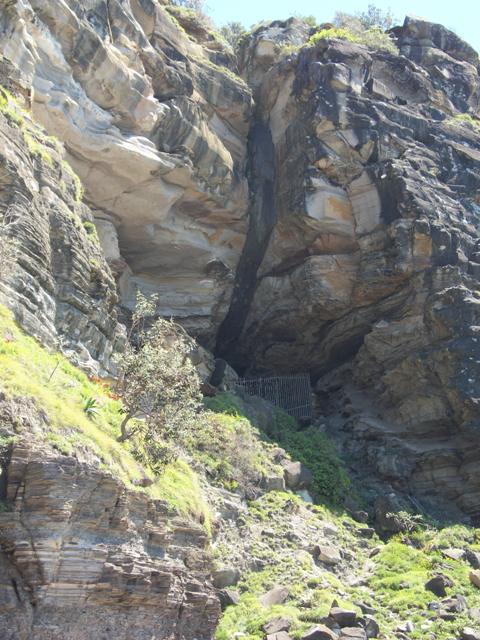 But Tom was not to be tempted, and that "little bit" struck terror even to my heart, though I was determined upon prosecuting my discovery to the utmost. From the ledge on which we stood, we could only see just two or three feet' of downright slippery descent, and beyond that nothing but the black rocks two hundred feet below, and the crested waves breaking on them in white foam.
But Tom was not to be tempted, and that "little bit" struck terror even to my heart, though I was determined upon prosecuting my discovery to the utmost. From the ledge on which we stood, we could only see just two or three feet' of downright slippery descent, and beyond that nothing but the black rocks two hundred feet below, and the crested waves breaking on them in white foam.
"Follow me," said Collins, as griping a projecting point of rock, he slid down the track, dislodging the stones and pebbles, and sending them rattling down upon the rocks below in a regular shower. In another second he had disappeared, and I heard no smash, no cry of torture, so taking heart of grace, I laid hold of the point of rock - oh, if I didn't hold it tight - slipped down the path, shot round a corner, almost breaking my spine with the twist, found my feet laid hold of by somebody, who placed them firmly upon a stone, and then, looking round, perceived that the worst was really over, and that now there was a good plain track running down to the rocks.
My admiration, however, was somewhat marred by a pair of thick boots which, cocking rapidly down from above, struck me somewhat rudely over the head, and as Nat's feet happened to be in them, and, as wanting the guiding hands that had placed me on the friendly rock, they were thrown wildly about, the blows were rather more than I had calculated upon. Nat soon got his footing, and then began to abuse me for getting in his way instead of apologising for his carelessness. We now shouted to Tom that we were all right and bade him follow. As he saw that the thing was done so easily, he hardly liked to jib, so he sang out to us to wait for him, as he was coming. We looked upwards for him with some anxiety, and in the course of a couple of minutes we had a full view of "the boots." They and they alone stopped in sight for a full minute, and we began to fear that Tom had caught somewhere, when suddenly down came the boots and Tom too, all in a lump, sliding down on the hunkers' after the same fashion as I have seen children slither down a slanting board. He had taken the notion that if instead of griping the cliff as we had done, he stooped down in the way I have described he could guide and check his progress with hands and feet. Here he made a woeful mistake, for the breaks in the descent were too heavy, and poor Tom came jumping down kangaroo fashion, bumping and thumping against the rocks, and so completely done up, that if Collins hadn't caught hold of him, he would certainly have gone bumping and thumping to the bottom.
We now descended to the rocks by a comparatively easy path, and passing along to the southward of the point whence we had started, we followed the rocks round a small projecting headland, on the south eastern face of which the cave is situated.
It is about eighty feet above high water mark, and about twice that distance from the summit of the headland. When we had mounted to it, and stood at its entrance, we found that a kind of bank or platform had been formed in front of it, covered with coarse grass and with an extensive growth of wild parsley, that seemed to flourish here in great luxuriance. The entrance forms a kind of rude irregular gothic arch, about twenty or five-and-twenty feet high in the centre, - the interior of the cave, that is, its first compartment, being about twice that height, in consequence rather of the descent of the flooring of the cavern than of the rising of its roof. It has evidently at some former period been considerably deeper than it now is, as vast masses of rock that have fallen from the roof above lay strewn about, and heaped upon each other, particularly in the centre, to be gradually, but surely, covered by the fine sand that drifts in with every southerly breeze through the entrance, and also by the guano, if such it may be termed, deposited here by the myriads of bats that make this cavern their home. The first thing that strikes the visitor on entering is a long flaw or rent in the sandstone which is here the prevailing rock. This flaw runs along the centre of the whole length of the roof of the cavern, being about three feet in width, and in a perpendicular position, and is filled up with a highly ferruginous sandstone, sounding particularly hard and metallic when struck.
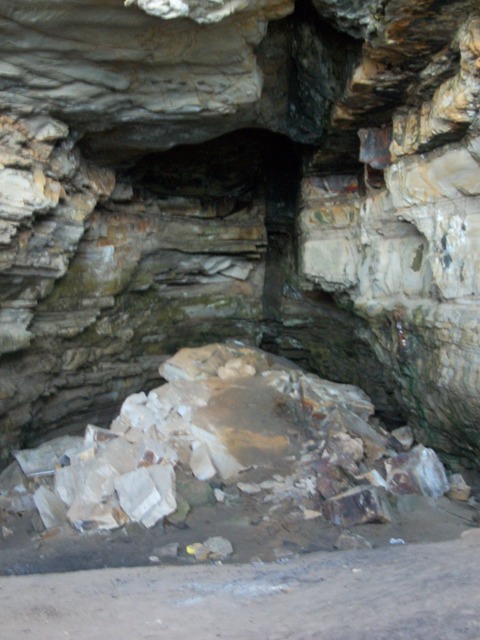 At about eighty feet from the mouth, the floor is covered with immense boulders of stone that have fallen from the roof of the cavern, and almost block up the way to the second compartment. A great part of these has fallen during the bad weather of the last year or two, a continuous rain, followed by a thunderstorm, being sure to bring down some one or more of the huge projecting masses that bulge out from the roof, and threaten to fall at the smallest provocation. Passing round this heap of debris, we now light our candle, for the mass of wreck so far shuts out the light of day as to render artificial light necessary.
At about eighty feet from the mouth, the floor is covered with immense boulders of stone that have fallen from the roof of the cavern, and almost block up the way to the second compartment. A great part of these has fallen during the bad weather of the last year or two, a continuous rain, followed by a thunderstorm, being sure to bring down some one or more of the huge projecting masses that bulge out from the roof, and threaten to fall at the smallest provocation. Passing round this heap of debris, we now light our candle, for the mass of wreck so far shuts out the light of day as to render artificial light necessary.
We now find ourselves in what may he termed the second compartment, which has a more regularly arched and compact appearance than the first, though it is somewhat smaller, being about twenty feet in height and the same width across, whilst the first is at least forty feet high and as many feet in width. Here we can more clearly perceive the ferruginous character of the interloping seam or flaw that has doubtless been the primary cause of this peculiar formation. The drippings from this perpendicular inset between the native rocks hang down in long rust-coloured pendants of oxide of iron, whilst the rocks on either side are formed in regular horizontal layers, the edges of the different strata, and in fact every protruding point of this part of the cave being covered with a white efflorescence from the phosphate of lime that has gathered on them ; whilst here and there other emanations from the rocks have settled in small chrystals upon its face, and reflect back the rays of the candle in all the gorgeous colours of the prism.
This compartment is the favourite resort of the bats and birds, the lighting of the candle creating a regular commotion amongst the denizens of the place. That they have occupied it for many long years possibly for centuries, is probable from the fact that in rooting among the sand and guano that cover the floor to an unknown depth, Collins informed me that he had met with large masses of an ammoniacal salt, that it must have taken the simple laboratory of nature very many years to bring to the state in which it is found.
Somewhere about ninety feet from the heap which I take as forming the boundary between the first and second compartment the cavern narrows very considerably, and we enter by a passage about wide enough to admit four persons abreast into the last chamber of this extraordinary place. As the sides come closer together, so also does the roof descend, and a tall man would here be able, by a good stretch of his arms, to touch the top; and so it runs in for another twenty or thirty feet, sides and top gradually collapsing, until at last there is but the width of the flaw, and scarcely height sufficient for a man to sit down.
Here the iron percolations prevail, as in the second compartment those of the lime are most abundant ; and we strike against the interjected seam, and, by dint of much labour and perseverance, chip off from it a piece of rock which has all the appearance of being actually iron in a rude state of preparation. We also see portions of it lying in long seams upon the sandstone rock it has divided, and which appear burnt and charred as though it had been subjected to powerful electric action. We also look back now to the way by which we have entered, and just over the heap of rubbish and natural ruins that impede our sight, we mark the bright light of day, which, from the distance we are placed at, is chastened and subdued almost to a twilight.
Everything seems solemn and suppressed; all outward sound is shut out, and there is not even a drip from the roof above to break the pervading stillness. We speak in our ordinary tone, but our voices, crushed down by the massiveness around, sound as if we were conversing in whispers. We are in no grand echoing hall, the work of mans' hands that sycophantly sends back the compliments that are given to his skill. We see before us the work of the Great Architect of the Universe, who labours not by the hand, but employs the meanest and the humblest instruments to do His bidding, and who, with the drop of water or the grain of sand, hollows out mighty caverns, or builds up giant mountains. Nature seems to acknowledge the Almighty presence, and to stand silent and awestruck as she watches the never ceasing work.
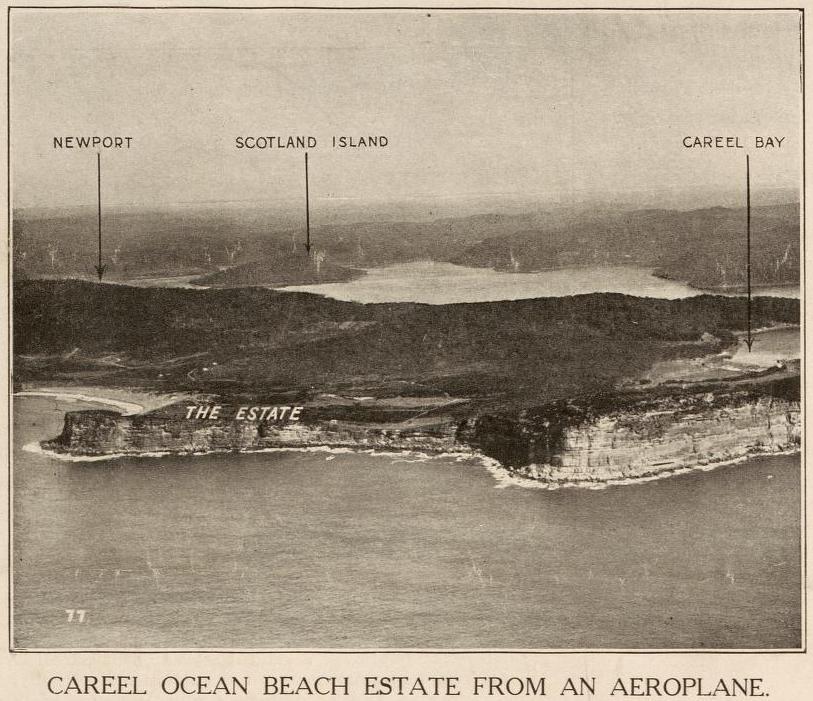
Section showing John Collins Dairy Fields - from Stanton & Son. Careel Ocean Beach estate [cartographic material] : "The hole in the wall", 2nd subdivision, 1922. MAP Folder 37, LFSP 499. Part 1. and Stanton & Son. Careel Ocean Beach estate [cartographic material] : "The hole in the wall", 2nd subdivision 1922. MAP Folder 37, LFSP 499. Part 2., courtesy National Library of Australia.
Something like these thoughts passed through my mind as I sat at the extremity of the cavern and looked out towards its entrance, a distance of over two hundred feet, and I could see that my companions were also somewhat similarly affected. We consequently retraced our steps with feelings very much sobered from those with which we had entered. Having collected a few specimens from the rocks around, we beat a retreat, and it was like coming into another world when we had emerged from the cave, and the hoarse roar of the waves beating upon the rocks, the songs of the birds, and the numerous and inexplicable sounds of nature and of life, struck vividly upon ears fresh from the oppressive stillness of the cave. We journeyed for some distance round amongst the vast heaps of rocks, on which the waves were breaking lazily though unceasingly, until we had reached St. Michael's Head, where the narrow seam of coal, alluded to in my last, was shown to me, together with the strata of carboniferous shale lying above and below it. ...
Having thanked Collins for his kindness and attention, we once more pushed ahead, the road now leading us across a long level piece of country that intervened between the sea and the waters of Creel Bay, until it brought us down to the margin of the latter. Arrived here, we had before us as pretty a marine picture as ever painter sketched, and as directly opposite to the one we had but so recently left as could be well conceived. The flat level land had here narrowed to some sixty rods in width, being backed by a heavily wooded range, the base of which was here and there encumbered by large masses of rock, from which the incumbent soil had been washed, and which now protruded in huge boulders, or lay out bare and detached from their native beds. On the margin of the bay were three little whitewashed slab huts with bark roofs, the passionate squalling of an infant that proceeded from one of them would have given evidence of their being inhabited, even if we had not seen two or three barelegged and barefooted children peering at us round the corner of the house. (To be continued.) MY HOLIDAY. (1861, September 2). The Sydney Morning Herald (NSW : 1842 - 1954), p. 3. Retrieved from http://nla.gov.au/nla.news-article13057913
ST. MICHAEL'S ARCH.
This beautiful Arch is situated on the estate of the late Very Reverend J. J. Therry, about three miles south of Broken Bay. As the scenery along. the coast from Manly Beach to the Bay is of the loveliest description, we advise all lovers of the picturesque to hire a spring cart from Mr. Miles - who lives about half a mile from the Pier Hotel - and proceed, early in the morning, to Mr. Collins' house, about thirteen miles distance, so as to be able to inspect this extraordinary specimen of natural architecture, and to return to Manly the same day if necessary.
As this excursion may gradually become fashionable, we quote a description of the places on the road from the late Postmaster- General Raymond's valuable work, the "Post Office Directory for 1855."
"Seven and a half miles from North Harbour, - Jenkins' house ; the road for the last mile along a level sandy beach. On the left is Narabeen lagoon. Mr. Jenkins has a snug house here, and much land in cultivation, which is an agreeable prospect - from the sea. Eleven and a half miles from North Harbour -Hut on the sea shore. The path from the Pennant Hills Road reaches the sea, and joins this coast road at the farm of one Foley - a tenant of. Mr. Wentworth's ; the distance from thence being twelve miles. About half a mile further on is the south-east arm of Pitt Water, on which there are some small cultivated farms. The head of Pitt Water as seen from the heights along which the road or path leads, is equal to any lake scenery, and there are many romantic spots, with good land, on its banks, which might be converted into good farms. Thirteen miles from North Harbour - Several farms and cottages. Fourteen miles- The Rev. Mr. Therry has a grant here. Fourteen and three-quarter miles - The Hole-in-the-Wall, being a rocky projection forming a rude archway with the shore."
The arch mentioned by Mr. Raymond is about twenty-two feet across the inside, and between thirty and forty feet high underneath. The rocks, of which it forms a part, are seventy feet in height - the colours of these rocks are exceedingly beautiful. At low water the visitor can pass through the arch.
Ascending the cliffs, a view of Pitt Water is beheld, being the harbour belonging to this estate. If an arrangement were made to have a small steamer plying along the beautifully wooded, lofty, and precipitous shores of the Hawkesbury River, parties of travellers could meet it at this spot, avoiding the disagreeable sea voyage by coming from Manly by land. The steamer could convey them from Mr. Collins' house to Windsor, and the train would take them back to Sydney - it being understood that the Windsor railway will shortly be completed.
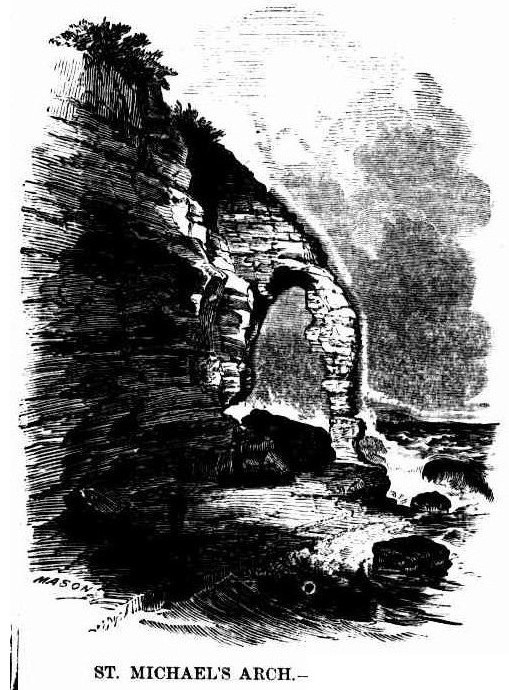
Illustration: ST. MICHAEL'S ARCH.
ST. MICHAEL'S ARCH. (1864, October 15). Illustrated Sydney News (NSW : 1853 - 1872), p. 3. Retrieved from http://nla.gov.au/nla.news-article63512130
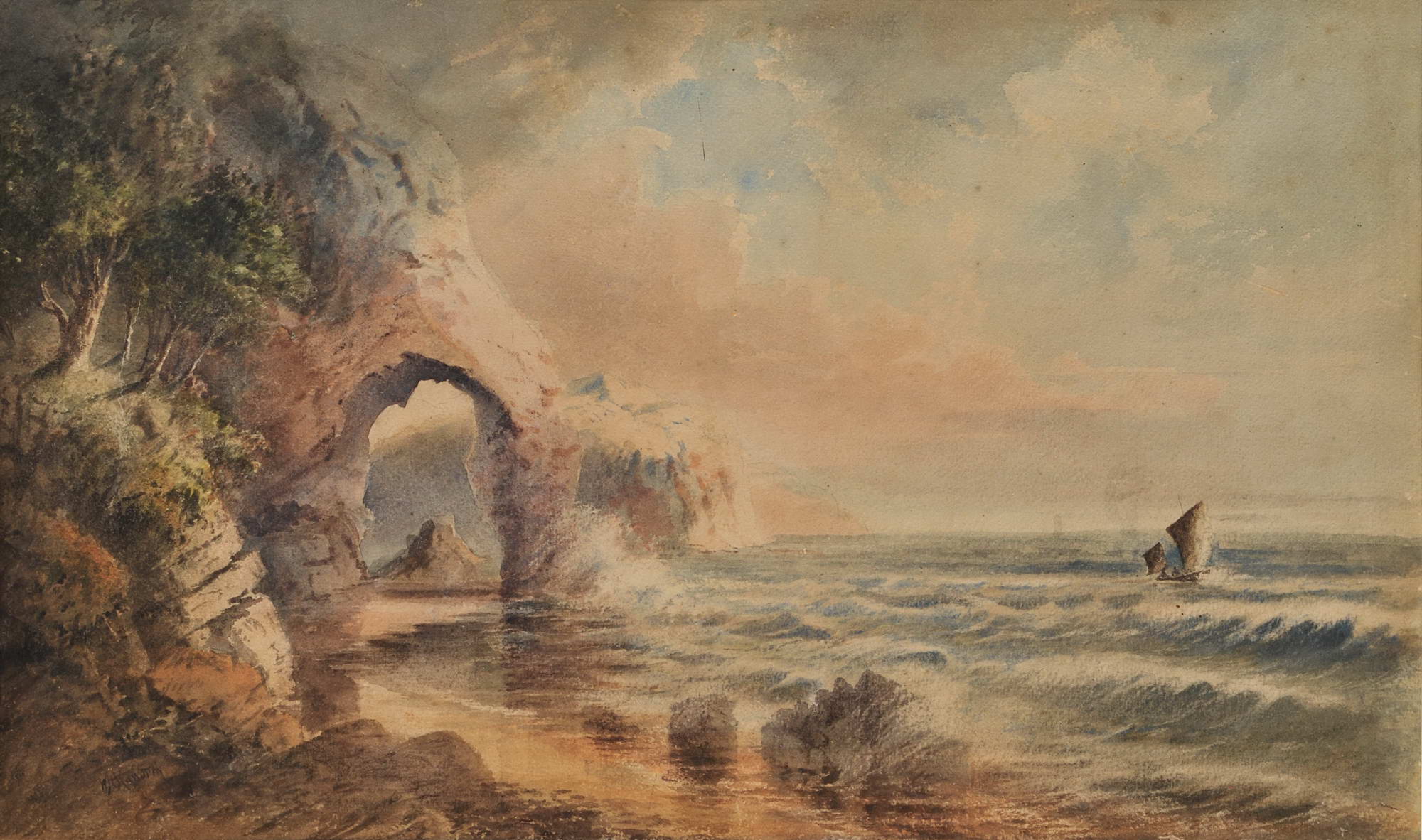
W.H. Raworth (Brit./Aust./NZ, c1821-1904). St Michael’s Arch, NSW [Avalon] c1860s. Watercolour, signed lower left, obscured title in colour pencil verso, 34.2 x 56.5cm. Tear to left portion of image, slight scuffs and foxing to upper portion. Price (AUD): $2,900.00 at:https://www.joseflebovicgallery.com/pages/books/CL181-53/w-h-raworth-c-brit-aust-nz/st-michaels-arch-nsw-avalon
St. Michael's Arch 1867 - The storm that turned an arch into a pedestal:
BROKEN BAY.
[FROM OUR CORRESPONDENT]
June 24 – We have had tremendous weather, but, as far as Pitt Water is concerned, no damage has been done with the exception to one of our picturesque curiosities, St. Michael’s Arch. It has at length to the too mighty elements and the destroying influence of time, that which was the admiration of all who have beheld it is now almost baseless fabric-there is only about one half of the outer support left, looking at it at a distance it has the resemblance of a coloured pillar. In its fall it carried a large portion of the overhanging rock with it, a thousand tons of gigantic boulders, and in such masses that I think it will stop the ingress from that part to the cave, but at yet we have had no close inspection for the rollers are dashing to the height of the stupendous rocks. The only idea I can give of the gale is that the froth of (not spray) the sea came over Mount St. Joseph, opposite the house, half a foot in size, and spread itself down to the dam, at times shading the heights of the mountain,-its resemblance was that of an overwhelming snow storm.
The sea at Barranjoey washed away the flower garden in front of the Chinamen's huts, taking soil and all, so that the beach comes close up to their door. There must have been awful havoc in the Hawkesbury, for all the beaches from Barranjoey to the Long Beach are strewn with fragments of houses, boxes, chairs, door frames, dead pigs, hay, wheat, broken bedsteads, weather-board sides of houses, oranges with large branches, pumpkins, melons, corn cobs, and other debris, that scarcely any portion of the beaches can be seen. Mr. Conolly picked up a workbox, in which was contained a number of receipts and letters directed to Mr. Moss, Windsor. The beaches on which are the debris is Barrenjoey, Whale Beach, Collins's Beach, Mick's Hollow Beach, Farrell's Beach, Mona Beach, and Long Beach, so it may be imagined the great extent of destruction. BROKEN BAY. (1867, June 27). The Sydney Morning Herald (NSW : 1842 - 1954), p. 2. Retrieved from http://nla.gov.au/nla.news-article13144304
BROKEN BAY. [From the Herald's Correspondents.]
June 24. — We have had tremendous weather, but, as far as Pitt Water is concerned, no damage has been done, with the exception to one of our picturesque curiosities, St. Michael's Arch. It has at length yielded to the too mighty elements and the destroying influence of time,— that which, was the admiration of all who have beheld it is now almost a baseless fabric,— there is only about one half of the outer support left, looking at it at a distance it has the resemblance of a colossal pillar. In its fall it carried a large portion of the overhanging rock with it, a thousand tons of gigantic boulders, and in such masses that I think it will stop the ingress from that part to the cave, but as yet we have had no close inspection, for the rollers are dashing to the height of the stupendous rocks. The only idea I can give of the gale is, that the froth of (not spray) the sea came over Mount St. Joseph, opposite the house, half a foot in size, and spread itself down to the dam, at times shading the heights of the mountain, — its resemblance was that of an overwhelming snow storm. The sea at Barranjoey washed away the flower garden in front of the Chinamen's huts, taking soil and all, so that the beach comes close up to their door. There must have been awful havoc in the Hawkesbury, for all the beaches from Barrenjoey to the Long Reach are strewed with fragments of houses, boxes, chairs, doorframes, dead pigs, hay, wheat, broken bedsteads, weatherboard sides of houses, oranges with large branches, pumpkins, melons, corn cobs, and other debris, that scarcely any portion of the beaches can be seen. Mr. Conolly picked up a workbox, in which was contained a number of receipts and letters directed to Mr. Moss, Windsor. The beaches on which are the debris is Barrenjoey, Whale Beach, Collins's Beach, Mick's Hollow Beach, Farrell's Beach, Mona Beach, and Long Reach, so it may be imagined the great extent of destruction. BROKEN BAY. (1867, June 29). Sydney Mail (NSW : 1860 - 1871), p. 11. Retrieved from http://nla.gov.au/nla.news-article166799304
Many resident historians are fairly certain that the above was written by then resident in this region John Collins, or his brother Frank, who worked occasionally at the Broken Bay Customs Station, Barrenjoey headland during these years. Mr. Conolly, who is also mentioned, became a relative by marrying one of the Collin's ladies.
It is not apparent from the above reference to 'Creel Bay' that visitors to the Collin's Dairy Farm were becoming more frequent, including their landlord:
Passing Burraujuee Head, which spreads out East and West like the head or a hammer at the end of along, narrow isthmus, which may not inaptly he compared to the handle, we steamed up Pittwater, and entered tint arm on its Eastern side upon which Father Therry's property is situated. As we proceeded up the Bay, the beautiful scenery on every side — so similar in its general character to that of our own harbour, and yet so different in its arrangement and general effect — excited the unqualified admiration of everyone on board. The situation of Pittwater and the beautiful country which surrounds it on every side renders it particularly available for the foundation of a watering place, which it will probably be at no distant period, when it becomes fashionable, for our citizens and their families to seek for change of air and scene during the heats of summer.
The steamer having landed its freight at the wharf constructed by Father Therry for the convenience of persons residing in the locality, and for those excursionists to whom he might give permission to land upon his property, they proceeded to walk towards the Cave, one of the chief attractions of the day's excursion. The path lay across a pleasant, undulating country to the rocks fronting the ocean, on the face of which the Cave is situated. A path has been constructed on the ledges of rock jutting out from the face of the cliff, and presenting in some places difficulties of approach to it which might have deterred many from venturing on the expedition had they been aware of them. The steps were frequently so steep and narrow that the slightest slip might have subjected a person to serious injury by precipitating him from a height of thirty or forty feet on to the rocks below, very similar to those at the base of the Gap, and against which the waves dashed with violence as great as we see at that spot, with which so much melancholy interest is associated. After what we had heard of the Cave itself, we certainly were rather disappointed on gaining the entrance: it is only by scrambling over the rooks, taking up a position at the extreme end and looking back towards the entrance that the full solemnity of the scene can be realised. The dim unearthly light streaming through the entrance and broken up by the projections of the roof and sides left an impression upon the mind not easily to be effaced; it was a fitting scene for all the horrors of the incantation scene in per Freischutz, its resemblance to which was rendered more striking by numbers of bats which flitted to and fro through the gloom;or to that scene in Macbeth where the Weird Sisters' Round about the cauldron go.'
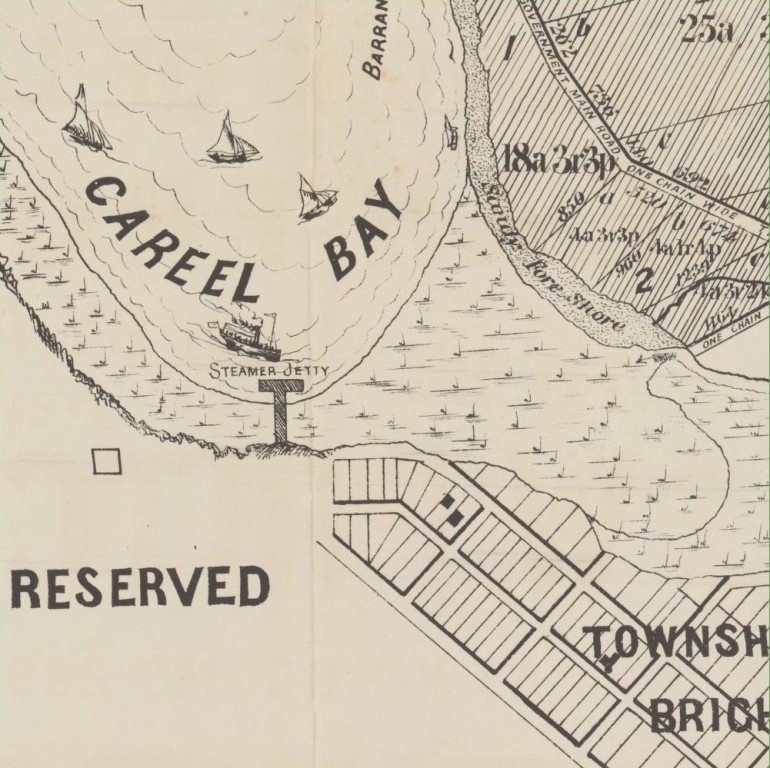
...Below shows 'Mount Patrick and Dam constructed by Collins.
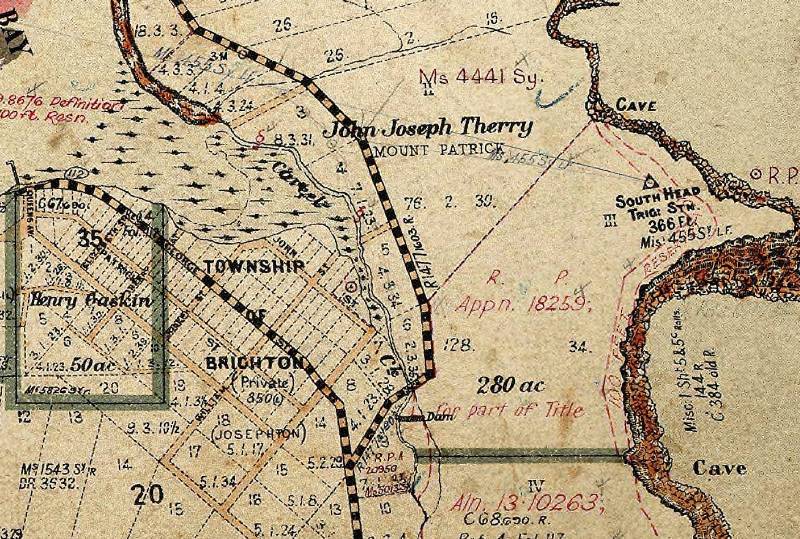
It was intended that Father Therry should have delivered the inaugural lecture of the season of St. Benedict's Society in St. Michael’s cave, but he was compelled, with great reluctance, to turn back without having reached it, having found the journey too fatiguing for him.
A great number of the excursionists scattered themselves in the bush and on the shores which skirt the beautiful bay, and several employed themselves in shooting and fishing. The Collaroy left Pitt Water about six o'clock in the evening and arrived in Sydney a little after eight no accident having occurred to mar the pleasures of a most agreeable day. Among the guests onboard we noticed the Very Rev. J. J. Therry Archpriest, Rev. Dr. Powell and Fathers Anselm, Corish, Donovan, McGirr, the Mayor of Sydney, with Mrs Oatley and family, &c. &c. The Band of the 12th Regiment had been engaged by the committee and played a selection of drama and other music which tended greatly to increase the pleasures of the day.
We must not omit to mention the extremely discreditable conduct of those who without asking any permission of Father Therry, on whose property St. Michael's cave is situated, very coolly advertised the Kembla to proceed there on another occasion at a less rate than the Collaroy, to the great annoyance and discomfort of those who had asked and obtained permission of Father Therry to make use of his ground... PITTWATER. (1862, April 23). Freeman's Journal (Sydney, NSW : 1850 - 1932), p. 6. Retrieved from http://nla.gov.au/nla.news-article115761495
So what was he like? What may he have looked like? He may have looked like grandson John Roche, 'Father of the Pittwater Regatta' - child from his daughter Katherine's marriage to James Joseph Roche of Bay View.
He was community minded, most probably with his brother Frank built the wharf people landed at, the small church at Careel Bay people attended as well as the schoolhouse in later years that children at the lighthouse and environs were taught at, on the Collins farm, served as a juror in 1871, attended political meetings, allowed an inquest to be held at his home, saw his family caught up in the Farrell's attacks upon the Therry relatives at Mona Vale, lobbied with other community members to get roads built and mails delivered, and was a staunch Catholic, a man who, along with the work of Rev. J J Therry, worked to establish the rights of his fellow Erin folk to practice their religion in this new land and support those still suffering from what was going on in the 'old home', not just in Pittwater but also in Sydney town. His chldren and their husbands were part of the community here. He and Honorah lost children along the way and raised their grandchildren of those they had lost or encouraged their own children to look after these nephews;
FIRE AT PITT WATER -In our issue of Friday last, was stated that the City Coroner was that day to proceed to Pitt Water to hold an investigation respecting the burning down of some buildings on a farm called Mona Vale, the property of Captain Darley. The inquiry was commenced at the house of Mr John Collins, at Pitt Water, on Saturday last, and adjourned to Monday, when it was resumed and concluded It appeared from the evidence that the farm in question was tenantless a considerable time, and during this time it was used as a common by a Mr. Farrell (who had more cattle than he could feed on his own place) and one or two others. About four months ago the farm was taken by a Mr. J. Therry, who at once took insurances for protecting his farm from the inroads of other people's cattle. An ill feeling was consequently engendered, and one settler re-marked that Mr Therry would not stop six months at the farm. Some time ago an effort was made to have a pound established in the district, and all the settlers in the neighbourhood signed a requisition to the hon the Secretary for Lands for this pound, with the exception of Mr Farrall, who refused. On the 5th of November last the farm was left in charge of a man named Madden, who with another man named Turner, was employed to work on the farm, Mr Therry himself being in Sydney. On the day in question, the two men left the buildings, consisting of a slab built dwelling-house and detached kitchen, &c, valued at£100, immediately after breakfast, and went to a distant part of the farm to work they roturned to dinner and found everything as they left it in the morning After dinner they again left for their work, and between three and four o’clock smoke was seen in the direction of the buildings When the men Madden and Turner returned in the evening, a heap of ashes was all that remained of the dwelling house and kitchen 1 ho house w as situated some considerable distance from any other house in the district, at about 3o'clock Mr Farrell was seen near the house by a Mr. Taylor, who is at present superintending some work at the Custom-house station, at Pitt Water. A number of witnesses were examined, but there was no direct evidence to show who set the house on fire, though it was pretty clearly shown that the fire was the work of an incendiary. The jury returned the following verdict, " We find that the dwelling-house and out-houses at Mona Vale, were willfully and maliciously set fire to on the 6th November, but the evidence does not clearly show who the guilty Person or persons may be Mr. Parker, the coroner, desired to express his thanks to Mr. Collins and Mr. Ross, Custom-house officers, for their hospitality during his short stay in the district. HOBART TOWN. (1862, December 3). The Sydney Morning Herald (NSW : 1842 - 1954), p. 4. Retrieved from http://nla.gov.au/nla.news-article13070361
Jeremiah Joseph Collins deposed 'I am thirteen years old, and am the son of Mr. John Collins, of Pitt Water. I know the prisoner, and also Mr, Therry's farm at Moua-Vale. I know the calves he had last June, and went with Mr. Therry's son in search of them on the ..th June.CENTRAL CRIMINAL COURT.—MONDAY. (1865, February 7).Empire (Sydney, NSW : 1850 - 1875), p. 2. Retrieved from http://nla.gov.au/nla.news-article60565398
FUND FOR THE RELIEF OF THE RELEASED IRISH STATE PRISONERS. Sir, — I herewith enclose the sum of 5s. in postage stamps in aid of the Liberated state prisoners, lately in bondage at Swan River of Western Australia. You will please acknowledge this in your next issue of the Freeman's Journal. — Yours very sincerely, JOHN O'BRIEN. Collected by Mr. J. Collins, Pitt Water. Card 112. — John Collins, Joseph Nagle, and Michael Madden, each 10s. ; A Friend, and Mrs. Madden, each 5s. ; Mrs. Connolly, 3s. ; Mrs. Swanson, and Mrs. Collins, each 2s 6d.;Miss Kate Collins, 2s. FUND FOR THE RELIEF OF THE RELEASED IRISH STATE PRISONERS. (1869, September 18). Freeman's Journal(Sydney, NSW : 1850 - 1932), p. 7. Retrieved from http://nla.gov.au/nla.news-article11543310
SWANSON. — At her father's residence, Pittwater, on the 6th instant, Ellen, the beloved wife of Charles Swanson, Esq., and eldest daughter of John Collins, Esq.,aged 26. Requiescat in pace. Family Notices. (1874, October 10). Freeman's Journal(Sydney, NSW : 1850 - 1932), p. 8. Retrieved from http://nla.gov.au/nla.news-article11547820
THE FRIENDS of Mr. JOHN COLLINS, of Pittwater, are respectfully invited to attend the Funeral of his deceased DAUGHTER, Mrs. Ellen Swanson ; to move from the Catholic Church, St. Leonards, North Shore, THIS DAY, Thursday, at 12 o'clock, and proceed to the Catholic Cemetery, Lane Cove Road. JAMES CURTIS, Undertaker, 59, Hunter-street. Family Notices. (1874, October 8). The Sydney Morning Herald(NSW : 1842 - 1954), p. 8. Retrieved from http://nla.gov.au/nla.news-article13338248
SWANSON — On April 7th, at Forbes, Charles John Swanson, son-in-law of John Collins, Pittwater, aged 39 years. Requiescat in pace. Family Notices. (1878, April 20). Freeman's Journal (Sydney, NSW : 1850 - 1932), p. 12. Retrieved from http://nla.gov.au/nla.news-article111098081
COLLINS—FITZPATRICK.—February 4, at St. Mary's Cathedral, Sydney, Jeremiah, eldest son of John Collins, Pittwater, to Kate, youngest daughter of the late Garrett Fitzpatrick. Family Notices. (1878, February 11). The Sydney Morning Herald (NSW : 1842 - 1954), p. 1. Retrieved From http://nla.gov.au/nla.news-article13407540
A procession was then formed, which marched to the site of the new school just above Lavendar Bay. The school children, marshalled by their teachers Mr. Shannon, Master Taylor, and Miss M'Glinchy, followed his Grace's carriage, then the societies and members of the congregation, the clergy and members of the School Board, Messrs. P. Hayes, M. M'Mahon, Lenehan, Stevenson,Hughes, Byrne, and Wall bringing up the rear.On the ground on the arrival of the procession were — Very Rev. Dean Kenny and Father Dillon,visitors from Sydney and members of the congregation, who had been at the first Mass, Messrs. Thomas Dalton, J. T. Toohey, Dr. McDonagh. J.J. Moore, J. Hughes, J. J. Spruson, E. J. Rubie, Cannon, W. Hughes, Wardell (the architect of the building), J. Baxter, J. P. Garvan, J. Keary, S. Kerr, J. Collins, Pittwater, &c, &c.His Grace having laid the stone with the usual ceremony, Father Wm. Kelly, S.J., preached, taking his text from the latter part of the epistle of the day (the first Sunday in Lent). I am sorry that circumstances prevented mo from being able to give you even a faint outline of it. I need scarcely say it was like all the Rev. gentleman's sermons, logical,' eloquent, and elaborate, and was listened to with rapt attention by the very large number assembled, which included many of other denominations attracted from the adjacent churches. The usual collection on such occasions was then made, and amounted to upwards of £150. ST. LEONARDS. (1879, March 8).Freeman's Journal (Sydney, NSW : 1850 - 1932), p. 15. Retrieved from http://nla.gov.au/nla.news-article110563676
His hospitality became a by-word for many a visitor and even those who happened here by mischance:
About two miles further on, from another eminence, a view suddenly breaks on the way-farer, certainly, unsurpassed, we think, in this or any other country. It is a magnificent valley, nearly surrounded by hills, in the centre of which is the dairy farm of Mr John Collins, nearly opposite whose door rises, to the height of 360 feet, the South Head of Broken Bay. On the west side are the ranges that divide Pitt Water Harbour from the Hawkesbury River, and through a narrow flat, maybe seen the placid water of one of the numerous bays of this fine haven. This farm is a part of the property of the late Rev. Mr. Therry, R.C., and is also well covered with rich grass. Mr. Collins is seldom without a visitor, either by sea or land, and very few ever pass his hospitable cottage on the way to Barranjoey without calling. A RIDE TO BARRANJOEY. (1867, March 22). The Sydney Morning Herald (NSW : 1842 - 1954), p. 5. Retrieved from http://nla.gov.au/nla.news-article13150778
WONDERFUL ESCAPE FROM DROWNING. ON Monday last, Mr. W. H. Hargraves, son of Mr. Hargraves, the gold discoverer, and Mr. C. J. Burnsson of the member for the Hunter, both clerks in the Equity Court, accompanied by a young man named W. A. Balcombe, started in a boat for Broken Bay to spend their "vacation holiday" in procuring conchological specimens. They took provisions for a fortnight, and an equipment of everything necessary, their principal object being to dredge in Broken Bay. The party left in the morning, the wind being west, and about 2 in the afternoon they were a little to the southward of Barrenjoey. At that time a sudden squall, from the south-west struck the boat, heeling her over till the sea went over, and she lay with her sail in the water. Fortunately, Mr. Hargraves had the presence of mind to cut away the mast, when she righted, but in a water-logged and helplessly condition. The wind then rose considerably, and a heavy sea got up. The party were two miles from land, and that land a rocky, ironbound coast. By keeping the boat's head to wind they managed to pull towards the "hole in the wall" but upon nearing the coast their situation became even more inconveniently dangerous. The sea raised by the south-west wind broke with great violence upon the rocks, and in the sandy bay higher up the surf broke half a mile from the beach. They were now close to the rocks, with apparently no chance of getting on shore. The young men, however, displayed a presence of mind that accounts for their being alive to narrate their escape. Tying the dredge rope to a cooking stove, weighted with all the other iron they had in the boat, Mr. Hargraves hove this novel anchor into the sea, while his companions backed the boat cautiously towards the rocks. The dredge rope was not long enough, and after it gave out, a tent line was added to it, and then a doubled schnappers line, which, with the painter, just allowed the boat's stern to go close to the rocks. Burns and Balcombe waited their opportunity, and jumped; but in trying to hold the boat while Hargraves joined them, they slipped and were dashed with much violence on the rocks beneath. When Hargraves jumped out of the boat on the top of Burns and Balcombe, a wave then came up and left the party sprawling upon a sunken rock, and when the sea receded they were enabled with great activity to reach a more elevated rock. A big sea soon after lifted the boat up, and carried her against the rock. It must be remembered that this occurred during the heavy gale on Monday, which was felt severely here, and it is marvellous that the three escaped as they did, as the coast upon which they were cast ashore is as rocky and almost as high as the South Head. After getting onto higher ground, bruised and bleeding, and wet through, the party found a track round the cliff, and got to the farm of Mr. Collins, who lent Mr. Hargraves a horse to go on to Broken Bay, and treated his companions with the greatest kindness. The party returned to town yesterday evening, thankful for their escape. Their loss is considerable, as the boat cost nearly £50, without her stores and dredging, and other tackle. Boat Accident. (1874, July 11). Australian Town and Country Journal (NSW : 1870 - 1907), p. 11. Retrieved from http://nla.gov.au/nla.news-article70483323
A TRIP TO PITTWATER.
Some friends of mine having purchased part of the Pittwater estate recently offered for sale, were anxious to see the land, and they invited me to accompany them. Saturday last was fixed for the trip. On that morning we were all up betimes. The night before we agreed that whoever rose earliest should call the others. Being known to rise on the first sound of the ' cock's shrill clarion,' I was expected to rouse my friends. At 5 o'clock when I went to do so I found that one of them had been up two hours, the others even longer. They had evidently worried themselves into wakefulness all night, for which there was no necessity, as a late sleeper might catch the first Manly boat, by which we were to leave Sydney. Saturday morning broke in smiling silence on the city and suburbs: it was one of those mornings which call forth praise and prayer to heaven for the blessing of such a climate as we enjoy in this Southern land. The waters of the harbour from our point of view (the heights of North Shore)looked like several lakes which were as calm as millponds. Our unrivalled harbour, it appears to me, presents scenes at, daybreak and by moonlight that cannot be viewed at any other time.
In summer mornings, before the sun rises, you may see creeping over the waters of its various nooks and bays gauze-like exhalations, which magnify the ships and boats in the stream. On the appearance of the great, vaporizer the mist is dispelled and the grand picture we all admire is unveiled. The nocturnal beauty of Port Jackson one never ceases to admire. Music only is wanted to make a moonlight view of it one of the most pleasurable sensations. Another harbour, pre-eminent for its capacity and safety,' and no mean rival of our own is more blessed in this respect, for the melody of the Shandon Chimes supplies the void felt here. On this I ponder,
Where'er I wander,
And thus grow fonder,
Sweet Cork, of thee ;
Why thy bells of Shandon,
That sound so grand on
The pleasant waters
Of the river Leo.
On board the Royal Alfred we were joined by a young gentleman who was also a guest. There were not more than half-a-dozen other passengers besides our party. Some of them looked sleepy and sullen, and appeared as if they had parted on bad terms with Morpheus. One of them who was late had to jump on board. The unamiable mood in which he appeared soon gave way to perfect equanimity, the effect, as one observed, of the soothing influence of the incense from the North Shore gums.
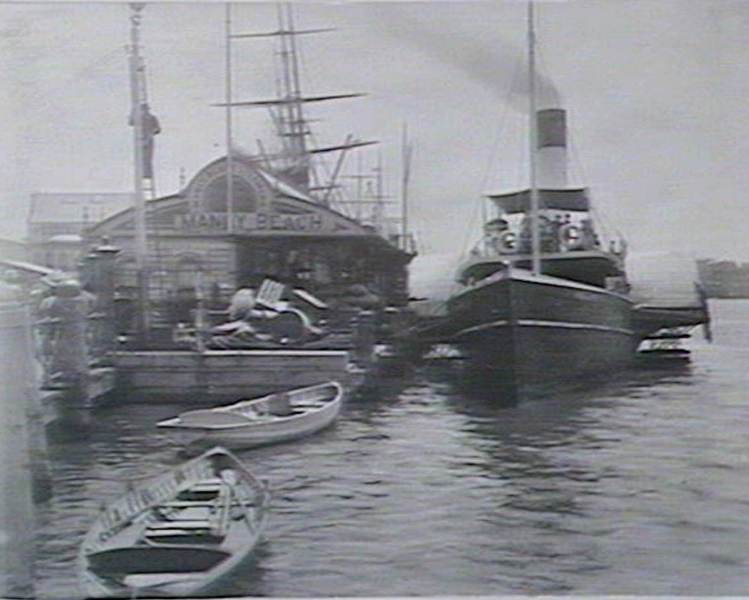
"Royal Alfred" at wharf Circular Quay, date; 9/1935 (?!), Image. No: d1_20453, courtesy State Library of NSW.
Arrived at Manly, we had an appetite for breakfast which many might, envy. This watering place reminds one of Passage, which Father Prout describes as situated
Upon the say;
'Tis nate and dacent,
And quite adjacent
To come from Cork,
On a summer's day.
The 'trap' which was awaiting us at, the hotel door, and which had been bespoken, was certainly not one of Kearey Brothers'. It had the appearance of a disused milk-cart., or a superannuated costermonger's conveyance. Our young companion did not like the look of it, but on being told there was no other available for our journey, he had sufficient of the Stoic in him to sink his personal feelings. Needs must when a Manly coach proprietor commands the drive to Pittwater. There is nothing very charming in the neighbourhood of the Pittwater road from Manly. Ducks and water fowl might find it a suitable abiding locality, but Manly-ites, if they have any regard for the future repute of their rising suburb, will extend it on the higher ground Spitwards.
Some four or five miles out of the township we overtook the 'royal mail coach' with its convoy conveying the mails and passengers to Boulton's or Newport at the head of the navigation of the Pittwater harbour. We sailed alone in this company until we crossed the Narrabeen Lagoon. As we emerged there from we descried a church, which appeared to be as well supported as the Smithy described in one of Swift's anecdotes. Seeing no residents around, we inquired where the congregation came from, but our Jehu was not a Matt Ryan. Indeed he was the most taciturn ' whip ' I ever travelled with.
Shortly after we entered upon the estate at Bilgola beach, where there is a deep leafy glen well adapted for the growth of bananas. On ascending to Bilgola Head a splendid view of the coast from Cabbage Tree Head to Barranjoee is obtained. The broad Pacific lay on our right at that moment as placid as Farm Cove. A splendid valley lay before us with the homestead of the patriarch of Pittwater, Mr. John Collins, in the distance; on the left, undulating land, well timbered.
Descending to the valley, we crossed the farm purchased by Mr. Canty, which is believed to be carboniferous. Some years ago competent judges gave it as their opinion that coal existed there. A bore of four hundred feet, made in the ground many years ago, when an attempt was made to test it, passed through strata that indicated the immediate vicinity of the black diamond. Mr. Coghlan's diamond drill would soon settle the question whether coal could be struck there. Mr. Collins's farm is situated in the valley, being flanked on the east by St. Michael's Cave and the South Head of Broken Bay, and on the West by Mount St. Mary. After doing full justice to Mr. Collins's hospitality, we sallied forth under his guidance to survey that part of the estate in which we were interested. We directed our steps towards Long Beach, nearly opposite Scotland Island, Pittwater Harbour. The land improved as we receded from the valley. Indeed we were agreeably surprised at finding soil and slope not excelled by any locality we had seen on the coast, except Irishtown, Lane Cove. My friends were delighted with their investment, and were only sorry they had not purchased more of the land.
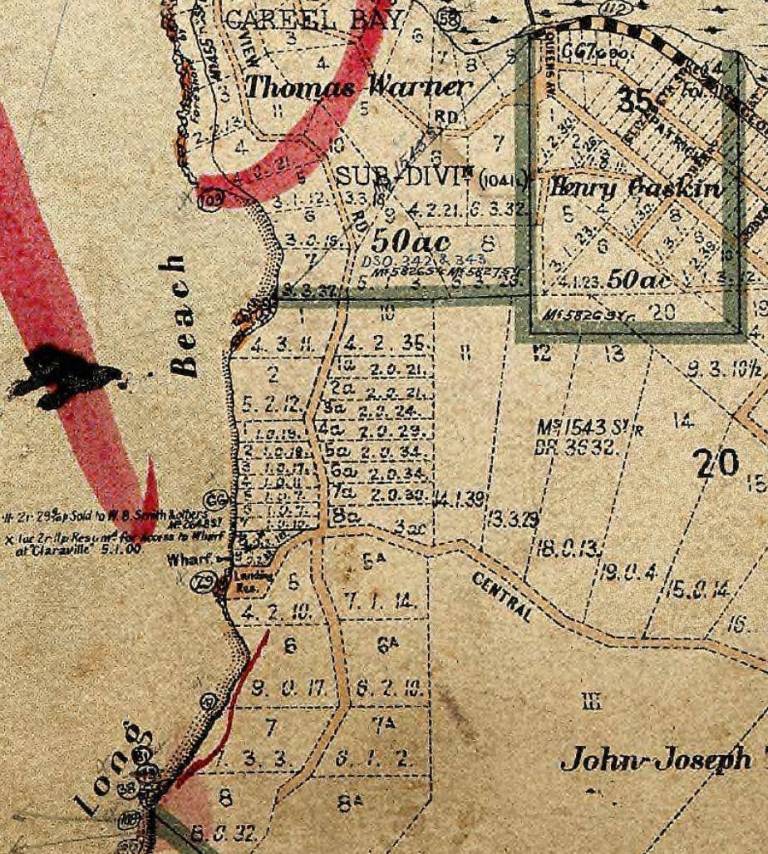
Pre- 1905 Land Titles Map - Showing 'Claraville' and 'Long Beach'. Courtesy Land Titles Office Historic records of NSW.
Pittwater estate belonged to the late Very Rev. Archpriest Therry, who bequeathed it to the Society of Jesus. It is surrounded on all sides save one by water; and it has been highly praised for its salubrity. It has a Catholic church, at which the Rev. Dr. Hallinan officiates once a month; it has also a Provisional school, attended by some twenty children. There is an incipient town called Brighton at Careel Bay, north-west of Barranjoee. The site is eminently unsuited for a township, and the sooner it is abandoned the better. A low swampy beach from which the water recedes at ebb tide, is not well adapted for settling on. A better site is that on the harbour higher up at Long Beach, where there is ‘ample room and verge ' enough, besides a moderately elevated coast and deep water. West Carbery, as we christened the place, is the site for a township.
A large block of land at Stokes's Point is reserved for a College. The scenery at Pittwater and on the greater part of the way thither is simply grand. When the road is better— (Mr. Collins informed us there is money on the estimates to form it all the way), and when a better style of conveyance is available, I know of no place or drive that will present so many attractions to the invalid, the pleasure or holiday-seeker. Everything conspires to quiet the anxieties of the mind and invigorate the body. Wooded slopes and deep ravines, picturesque views of ocean, beach, and headland, are features that would dissipate the megrims of a miser or restore peace to the mind of a rejected swain. Notwithstanding the discomforts we laboured under from the vile vehicle we had, we enjoyed the trip to and fro uncommonly well, and arrived at 7 in the evening at Manly without any mishap beyond that which a little application of Australian Ointment will remedy, as our young friend of bills and briefs said. CRUIG BARRY.11th May, 1880. A TRIP TO PITTWATER. (1880, May 22). Freeman's Journal(Sydney, NSW : 1850 - 1932), p. 19. Retrieved from http://nla.gov.au/nla.news-article133488037
‘In the midst of life we are in death' was sadly illustrated in the case of Mr. John Collins, of Pittwater, on Friday night, the 20th inst. Mr. Collins came up the Sunday before to attend the sale of the Pittwater estate, which took place on the 16th inst., his 66th birthday. From Monday to Friday he was making arrangements with a contractor for the erection of a cottage on one of his farms. Returning from Sydney on Friday evening by the half past 5 boat he fell overboard at Lavender Bay wharf, through, it is supposed, the bumping of the steamer against the piles. Owing to the noise of the engine the accident was not observed on the instant, and some short time had elapsed before Captain Butler, who has saved scores of lives from drowning, plunged in to the rescue. He soon brought Mr. Collins on board and proceeded with his steamer to Milson's Point, when he placed him in a cab which conveyed him to his brother-in-law's (Mr. Connolly), the Union Inn. Father Kennedy, S.J., and Dr. V. Browne were immediately in attendance, and both had strong hopes of his recovery until about 1 o'clock at night, when capillary bronchitis supervened. The deceased gentleman was an old colonist, having emigrated from Cork with his parents about 50 years ago. He was well known and widely respected, not only in Pittwater, where he was regarded as a patriarch, and where he resided for upwards of forty years, but also in the North Shore and in Sydney. He was a man of sterling principle, so fond of the right that he would not do wrong deliberately for a kingdom. He had a great contempt for the worldliness, avarice, and selfishness so characteristic of the present times, his own character being the very antipodes of these. On Monday morning a Requiem Mass for the repose of his soul was celebrated by Father Kennedy in the church of St. Mary Star of the Sea. The respect in which Mr. Collins was held was testified by the numbers of all classes who attended his funeral, which was the largest of any private funeral that has taken place here for the last twenty years. He leaves a widow, four sons, and a daughter, all, except one of the sons, living in Pittwater. May his soul rest in peace. ST. LEONARDS. (1881, May 28). Freeman's Journal (Sydney, NSW : 1850 - 1932), p. 10. Retrieved fromhttp://nla.gov.au/nla.news-article115457523
The Collins stayed in Pittwater, now land-owners - Honorah moving to live with daughter Katherine at Bay View, who married another Irishman in Australia:
ROCHE—COLLINS.—April 18, at the residence of the bride's mother, Rockvale, by the Rev. Dean Hanly, James Joseph, youngest son of John Roche, Esq., County Cork, Ireland, to Katherine M., youngest daughter of the late John Collins, Esq., of Pittwater. Family Notices. (1883, May 24). The Sydney Morning Herald(NSW : 1842 - 1954), p. 1. Retrieved from http://nla.gov.au/nla.news-article13535436
E.F. asks-What the letters of the registered horse-brand are of J. Collins, of Josephton, Pittwater. How are they placed?-J over 4 for horses. £ over g for cattle. Answers to Correspondents. (1883, June 2). Australian Town and Country Journal (NSW : 1870 - 1907), p. 18. Retrieved from http://nla.gov.au/nla.news-article71000007
IRISH NATIONAL LEAGUE. A committee meeting of the Central Executive Irish National League was held at the Rooms, Kidman's Buildings, on Tuesday evening. There was a good attendance of members. Mr. Charles O'Neill, vice-president, occupied the chair. The secretary read correspondence received since last meeting, which included a letter from Goulburn, enclosing £50 for the Evicted Tenant Fund, and a letter from Buckley's Crossing, containing £18 17s,from Rev. P. Byrne, Hurstville, enclosing £1 Is, and from Mrs. H. Collins, Pittwater, £1. IRISH NATIONAL LEAGUE. (1888, December 1). Freeman's Journal (Sydney, NSW : 1850 - 1932), p. 9. Retrieved from http://nla.gov.au/nla.news-article115459904
John Collins was a hard-working man who, wife his wife, raised a large family, and built up our community. Decades after he had passed on, his name was still revered:
DEATH OF MRS. COLLINS. Full of years spent worthily, Mrs. Honora Collins relict of the late John Collins, died on the 20th instant the residence of her son-in-law, Mr. J. J. Roche, Bay View, Pittwater. For more than half a century she had lived at Pittwater, and no family was better known or more highly respected than the Collins family of Careel Bay. Mr. and Mrs. Collins were natives of the County Cork, whence they emigrated 60 years ago. Soon after their arrival in the colony they settled on Father Therry's grant at Pittwater, where Mr. Collins engaged in grazing and farming. The district has always been a great health resort. Many an invalid from Sydney recruited his health at the hospitable homestead of the Collins family. The cottage was flanked by two hills, named Mount St. Joseph and Mount St. Mary by Mr. Collins.
It is told of him that he would allow none of his sick guests to leave until he saw that they were completely 'on their legs,' his test for which was a given time to ascend and descend these hills before breakfast. The remains of the deceased lady were brought on the 21st from Bay View to St. Mary's, North Sydney, where Masses were said for the repose of her soul. The funeral took place at Chatswood Cemetery, the family burial-place, the same day.
The chief mourners were Mr. J. Collins, of the Harbours and Rivers Department; Mr. P. Collins (sons); Mr. J. J. Roche, son in-law; Messrs. J. T. and E. P. Swanson, nephews. Among others present were Mrs. Black, of Barrenjoey Customs Station, Mrs. Midden, Mrs. Roche, Mrs. Earl, Mrs. Robertson, Mrs. F. Collins, Mrs. P. Collins, Messrs. D. J. Glacken, M'Teague, J.Wall, J. Crowley, H. Coyle, J. Macintosh, and Boulton. The Rev. Father Dowling, of St. Patrick's College, Manly, attended Mrs. Collins during her last illness, and officiated at the grave. May her soul rest in peace. DEATH OF MRS. COLLINS. (1897, October 30). Freeman's Journal (Sydney, NSW : 1850 - 1932), p. 16. Retrieved from http://nla.gov.au/nla.news-article115471628
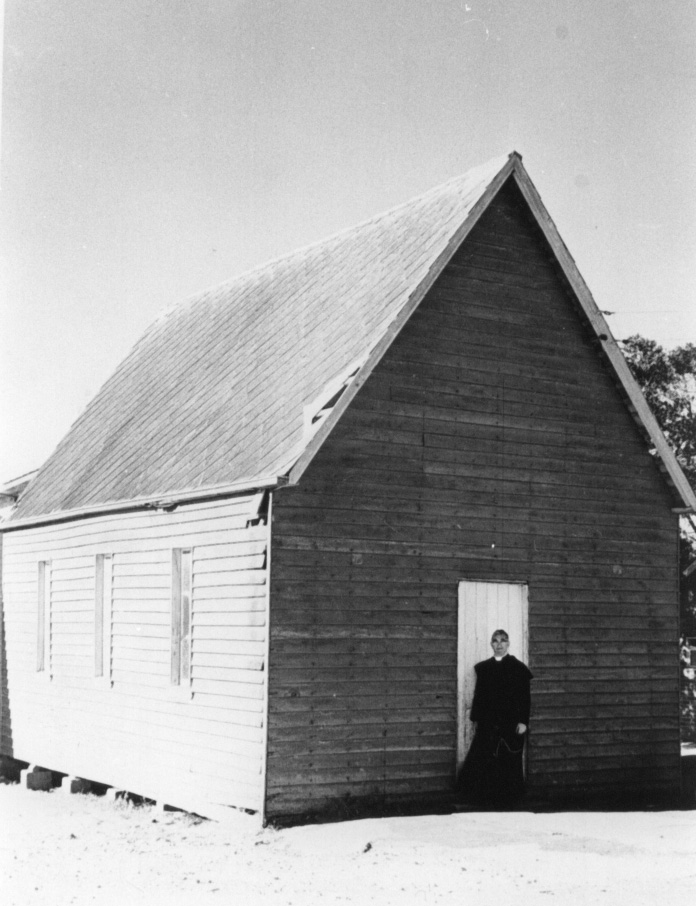
The little church at Careel Bay - built by the Collins family (?) - this was later moved to Narrabeen. (from an original photo held at Maria Regina, Avalon)
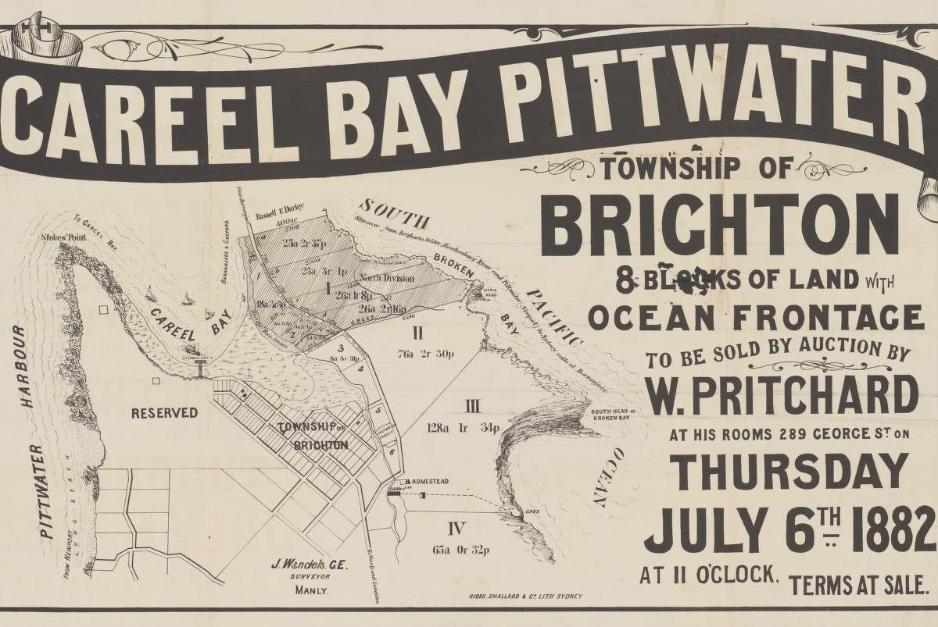
Careel Bay Pittwater [cartographic material] : township of Brighton, 8 blocks of land with ocean frontage - 1882. MAP Folder 135, LFSP 2160. Courtesy National Library of Australia.
References and extras:
Sparks, Jervis. 1992. Tales From Barranjoey.
Champion, Shelagh OAM and Champion, George OAM. 2013. Profiles of the Pioneers. Warringah Shire Library.
84. The Rev. John Joseph Therry, promised to Michael Bergin, 1280 acres,Camden. Advertising. (1838, May 4). The Australian (Sydney, NSW : 1824 - 1848), p. 2 Supplement: Supplement to "The Australian.". Retrieved from http://nla.gov.au/nla.news-article36856469
Case No. 160-Rev J. J. Therry and John O'Sullivan, in trust for Mary Ann Brown, widow. Fifty two perches, in the county of Cumberland, town of Sydney, parish of St. Phillip, allotment No. 2 of section No. 56. This was originally two allotments, and they were located it is alleged, about the year, 1813, toDavid Brown the younger and to Thomas Dunn. David Brown, senior, purchased Dunn's allotment, and conveyed to his son, D. Brown, junior, who sold both to his brother Thomas, deceased, who devised in trust as above to his widow for her life and then to his children. COURT OF CLAIMS. (1837, December 2). The Sydney Gazette and New South Wales Advertiser (NSW : 1803 - 1842), p. 4. Retrieved from http://nla.gov.au/nla.news-article2214264
FATHER THERRY. To the Editor of the Freeman's Journal. Dear Sir,— I send you the article for the publication of which in 1825 the late venerable Father Therry was removed from the office of chaplain. The individual at whose instance and by whose complaint he was so removed was known to Father Therry as late as 1823, as a mere layman and Secretary to Commissioner Bigge. On his return to…with a salary of £2000 per annum, a seat in both the Executive and Legislative Council of that day, a seat also at the board of the Australian Agricultural Company—and the chief dispenser of one seventh of the (lands of the colony with a plenitude of Government patronage and power. It was not the lots of the stipend of £100 a-year the good Father Therry had that he regretted, his connection' with the government often enabled him to serve many deserving persons by taking them off the government stores, -and allowing these persons to employ themselves in useful occupations as teachers, clerks and in other pursuits for their own advantage. I have myself known many of these individuals in after 'life as excellent members of society in every respect. I could detail numerous traits of dear Father Therry's excellence, labours, and wonderful seal, from the year 1827 when I first had the great happiness of knowing him and residing under his roof, as I did until February 1836— but I am now bowed down by his sudden and unexpected death— I trust,however, that at no distant day on account of his most useful life and labours will be given to the world by some young and zealous and able ecclesiastic.I have been thrown among men of almost every notion and condition for the past forty years, and I .can safely say that so disinterested and virtuous, and so noble a specimen of human nature as the late Father Therry has never come under my cognizance, — I am, dear sir, yours truly,J. O'SULLIVAN.Goulburn, 3rd June.
Allow me to add that it was the Hon. Christopher Hely Hutchinins, spoken of by Archdeacen M'Encroe in his sermon, that brought the case of Father O'Flinn before the British Parliament and not his brother Lord Donoughmore as Doctor Ullathorne and others have stated. I gave this information to that highly gifted and respected ecclesiastic when he was about to reply to Judge Burton, he, however, fell into error by giving the name of one brother for the other. It was at the instance of the Rev. John England, afterwards the famous bishop, that Mr. Hutchinson moved in the matter.J. O'S.
The Article, for the publication of which (in the Sydney Gazette), the Rev. John Joseph Therry was Removed, by Order of Earl Bathurst, from his Official Situation of Roman Catholic Chaplain of New South Wales. 'The Roman Catholic Chaplain has publicly to express his grateful acknowledgements to Mr. James Burke, of Airds, a native of the Colony, for his offer of five acres of cleared land, contiguous to Campbelltown, as a burial ground, and site for a chapel and schoolhouse, and for his still more liberal promise to give double that number of acres, if so many should be required for these purposes. It may be necessary here to state, that the Roman Catholics, who form the greater number of at least the free inhabitants of that, and of some of the adjoining districts, having no place to assemble in on the Lord's day, for the purpose of divine worship, but the open air (in which the prisoners of that persuasion are obliged to continue for hours together, on every Sunday, exposed to all the vicissitudes of the weather, in order to be exempted from a necessity of attending at ceremonies of which they cannot conscientiously approve); and having already liberally subscribed to the erection of the Sydney chapel, the (nods of which are indeed nearly, if not completely exhausted, decline contributing any further to that edifice, until they shall have first erected a temporary chapel in their immediate neighbourhood. And, as from a document which has been recently published, it may be inferred, that public provision is to be made for Protestant parochial schools exclusively ; and that, the children of the Catholic poor are to be either excluded from the salutary benefits of education, or compelled or enticed to abandon the truly venerable religion of their ancestors, according to the past and present system of the Orphan School establishment in the Colony ; and as the lesser of these evils is to be deprecated as a most serious one, the Roman Catholic Chaplain, with the fond hope of obviating both, it determined, so adjutant, immediately to form a Roman Catholic education society, into which, however, persons of any persuasion may be admitted, on subscribing to its funds fifteen shillings a-year, or one shilling and three pence per month. But, he has seriously to regret, that this design has not been anticipated or, that its execution has not been reserved for less humble and more efficient instrumentality than him. The intention of the Roman Catholic Chaplain to procure places of burial separate from those of the Establishment, will not be ascribed by an-person who happens to know him, to a spirit of liberality. The idea was first suggested to him by a personage of high rank and distinguished liberality and benevolence, of another persuasion, who had known by experience such a measure to be in strict accordance with the discipline of the Catholic Church, and calculated to prevent the collision or inconvenient interference of the respective duties, of clergymen of different societies, and the recurrence of an instance which had .... place, in which burial or surplice dues were required from the surviving friends of deceased Catholics, by a minister who had not officiated at the interments; and, on payment of them being refused, were enforced by him in his capacity of magistrate.' This precedent, however, he feels it his duty also to state, has neither been nor is likely to be adopted by the other Rev. Gentlemen of the Establishment, who with the Rev. Gentleman alluded to, who he sincerely believes on these occasions merely vindicated what he considered to be his just rights are in every way entitled to, and possess his unqualified respect. . , Sydney, June 14, 1825. CORRESPONDENCE. (1864, June 8). Freeman's Journal(Sydney, NSW : 1850 - 1932), p. 5. Retrieved from http://nla.gov.au/nla.news-article128804709
TESTIMONIAL TO MR. JOHN O'SULLIVAN. On Saturday last, pursuant to advertisement, the testimonial subscribed for by the friends of Mr. John O'Sullivan on the occasion of his retirement from the position of manager of the Commercial Bank, was presented in the hall of the mechanics' institution. There was a large attendance, consisting chiefly of old residents who have known Mr. O'Sullivan and in most cases had transactions with him during a long series of years. Mr. W. P. Faithfull, on whom, as chairman of the previous meeting and of the committee, devolved the task of presenting the testimonial, said that he was sorry he was not better adapted for public speaking ; and yet perhaps it was not necessary on this occasion that he should say much. The address which he was about to present from the inhabitants of the surrounding district as well as of the city of Goulburn, would explain what his feelings and those of other subscribers to the fund were, though inadequately and if this did not go far enough he must apologise to the people of the district on whose behalf he was acting for his inability better to express their feelings and good wishes towards Mr.O'Sullivan, while perhaps Mr. Davies, who-would speak on behalf of the town, would be able to supply any omissions on his part. He trusted that the testimonial would be ever held by Mr. O'Sullivan and his family as a proof of the feelings of respect and esteem with which he was regarded. He then formally presented the testimonial and read the following address : —To John O'Sullivan, Esq. Sir,— Hearing that you are about to retire from active service as manager of the Goulburn branch of the Commercial Bank, after having faithfully served that establishment for thirty one years, we feel we cannot let you leave us without an affectionate farewell. As soon as it was known that you had decided to depart from amongst us to reside in a district more congenial to your constitution, one feeling prevailed in the hearts of young and old — a wish to present you with a memorial of our regard, that it may be handed down to your family as a token that integrity and kind-heartedness such as yours are recognised and valued ; and we pray you to believe that, when you are far away, we shall miss you in your old accustomed place, and our hearts will always beat with a glow of pleasure at the mention of the name of ' O'Sullivan' our Goulburn friend. We wish you, in the autumn of your life, all happiness, and allow us to add that we shall-preserve a kind remembrance of Mrs. O'Sulllivan.-and your family. Believe us to be, With the deepest regard, Your sincere friends.
Mr. O'Sullivan, who was deeply affected, then-expressed the great pleasure with which he received the address and testimonial ; and being too much overcome by his feelings to read the reply he had prepared, requested that his son, Mr. John O'Sullivan would do so.
Mr. O'Sullivan junior read the following REPLY: To Wm. Pitt Faithfull, Esquire, and the other Gentlemen who have presented me with an Address, &c. Dear and respected Sirs, — When it was first intimated to me that you intended to honor me with an address and testimonal on my retiring from the post which I have held in this town for so many years, I own that I hesitated as to whether I ought to receive the latter from the circumstance that in my dealings with most of you I simply performed my duty both to the institution which paid me and to you who were the constituents of that institution. It was, however, mentioned to me by friends whose opinions I value that if I declined that which you resolved upon I should give cause of displeasure, and as nothing could be further from.my wish than to do the latter I cheerfully accept your too flattering address and your appropriate gift, assuring you, at the same time, that the former will never be forgotten by me, and although we know not what may be the ' vicissitudes of families,' circumstances will, I am persuaded, press hard upon me and mine before the latter shall be knocked down by the auctioneer's hammer.I leave Goulburn in a few days, it may not be forever. It has, as you are aware, many, and not easily forgotten, claims upon me. Should I live to revisit it I hope to find all of you and yours in the enjoyment of every possible happiness and blessing. In this wish I am sincerely joined by every member of my family. I am, dear and respected Sirs, With great esteem, your sincere friend, J. O'Sullivan. Goulburn, 25th May, 1867.
The Chairman then called on Mr. William Davies, who said that during the period of sixteen years he had been more or less connected in business transactions with Mr.O'Sullivan. Mr. O'Sullivan had said that he did no more than his duty for which he had been paid ; but there were different ways of doing the same thing ; and he must bear witness that Mr. O'Sullivan's conduct to him had always been marked with the greatest courtesy and kindness, it had been objected to Mr. O'Sullivan that he was not a public character; but there were very good and sufficient reasons why bank managers should not take any prominent part in public matters. They could not do so without taking sides; and if they became partisan the interests of the, bank would suffer. He therefore considers it an evidence of singular good taste that Mr. O'Sullivan had abstained from taking an active part in public affairs. He had received letters from Mr. Laidlaw of Yass, from Mr.Bradley, and from Mr. Newcombe of Queanbeyan enclosing their subscriptions to the testimonial and in each case regretting that the amount was limited to a guinea; and if time had allowed he had no doubt that there would have been many more such letters from almost every part of the colony. There was one thing he most deeply regretted, and that was that the state of Mr.O'Sullivan's health was inducing him to leave the district ; but he had sufficient confidence in the salubrity of the climate of Goulburn to believe that he would return ; and he sincerely trusted that a release from the cares of office would be found to re-establish Mr. O'Sullivan's health and that he would be once more residing amongst them, and would live long to continue performing those many acts of charity and benevolence which he was ever doing and instances of which had been daily related since -it was known that he was about to leave— acts which were never intended by Mr. O'Sullivan to be made known. It is one of the chief features of this movement that it was participated in by members of every church. Mr. O'Sullivan, while conscientiously believing that the church to which he himself belonged was the true one, yet ever held out the right hand of fellowship and charity to all without distinction of sect. He new begged leave to say that Mr. O'Sullivan was the only man in addition to the late Mr.Isaac Levy who ever proffered him (Mr. Davies)assistance in business. He had never forgotten the matter and should ever retain it in his most grateful remembrance ; and he had now in public to thank Mr. O'Sullivan, as he had before done in private, for his great kindness on that occasion as well as for his uniform courtesy towards him. Mr. O'Sullivan briefly returned thanks for the very kind manner in which Mr. Fathfull and Mr. Davies had spoken of him. Throughout the remarks of Mr. Faithfull and Mr. Davies, Mr. O'Sullivan's name was-received with great applause ; and Mr. O'Sullivan was similarly greeted when he came forward to address the meeting. Mr. Davis explained that the address would be elaborate copied and ornamented, so as to fit it for being framed and exhibited on the walls of Mr. O'Sullivan's house. Mr. O'Sullivan having incited those present to lunch, a number of gentlemen proceeded to the banking-house where an excellent, collation was spread, which all seemed to enjoy. The healths of Mr. O'Sullivan and family, Mr. John O'Sullivan junior, the directors of the Commercial Bank, and Mr. Paige the new manager,were drunk and duly responded to. Mr. O'Sullivan was affectionately bade good-bye, and his guests departed. The testimonial is a very handsome silver tea service weighing ninety ounces, and was the heaviest submitted for the approval of the committee. It bears Mr. O'Sullivan's crest on each piece, and also the following inscription : —'Presented to John O'Sullivan, Esq., as a proof of the esteem in which he is held by his friends in the city and district of Goulburn. 25th Mav,1867.' The service is now on view in the window of the City Book Mart. — Goulburn Herald. TESTIMONIAL TO MR. JOHN O'SULLIVAN. (1867, June 1).Freeman's Journal (Sydney, NSW : 1850 - 1932), p. 2. Retrieved from http://nla.gov.au/nla.news-article119439932
DEATHS. On the 7th instant, at his residence, Hunter's Hill, in the 68th year of his age, John O'Sullivan, native of Millcove, Berehaven,county Cork, Ireland, for many years manager of the Commercial Bank, Goulburn. May he rest in peace. Family Notices. (1870, September 8). Empire (Sydney, NSW : 1850 - 1875), p. 1. Retrieved from http://nla.gov.au/nla.news-article63110957
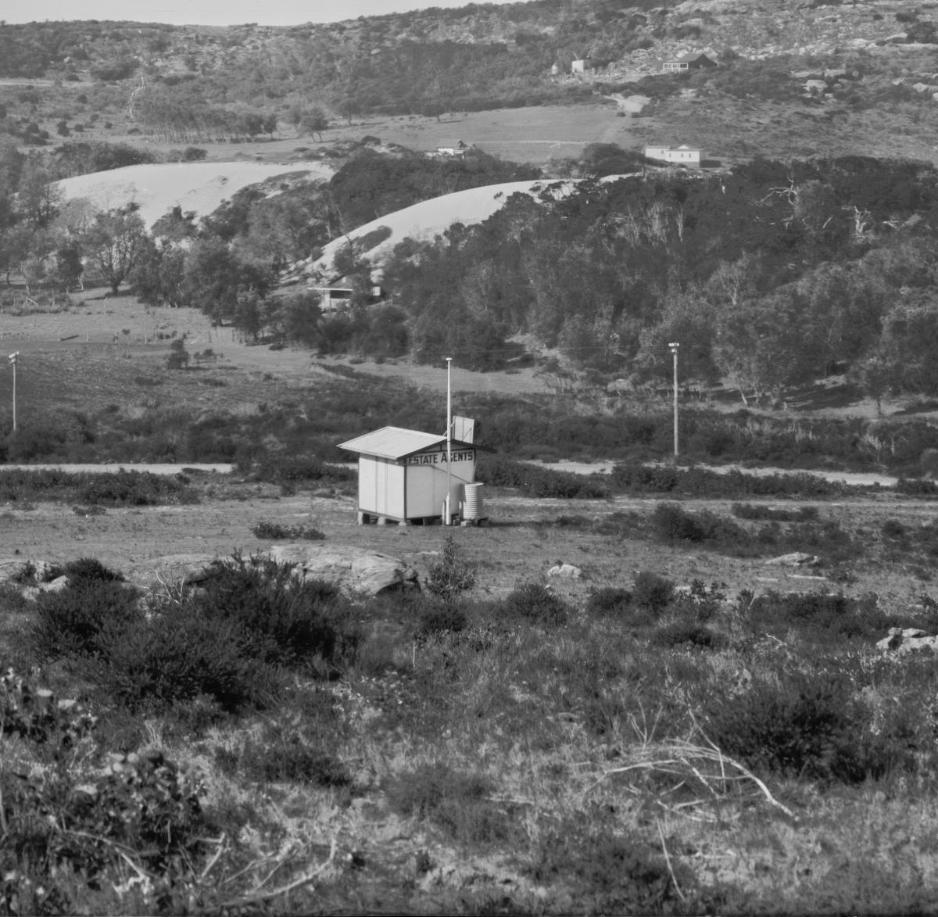
Section from - Panorama of Avalon Beach, New South Wales, ca. 1925, Enemark collection of panoramic photographs, Image No.: nla.pic-vn6217971, courtesy National Library of Australia.
John Collins of Avalon - Pittwater threads collected and collated by A J Guesdon, 2014.